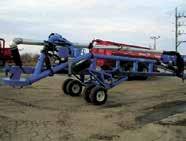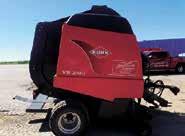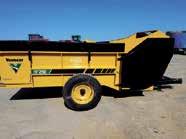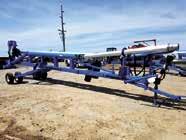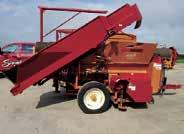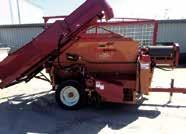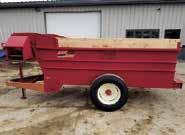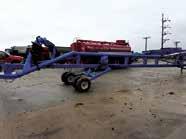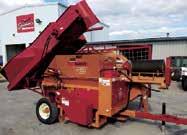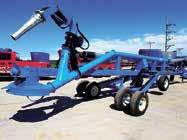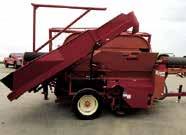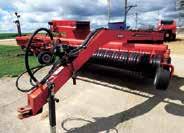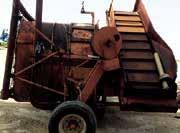DAIRY ST R
Volume 24, No. 19

Volume 24, No. 19
MANDAN, N.D. – Eighteen-year-old Dawson Holle may soon be swapping his chore boots for a suit and tie.
Holle will be sworn in Dec. 2 as a state representative for North Dakota’s District 31, making him the youngest representative in the state’s history. The teen grew up on a dairy farm and is a freshman at the University of Mary in Bismarck.

“I haven’t told too many people at college,” Holle said. “Those I have told don’t really believe me. They have to Google me.”



Holle’s family manages Northern Lights Dairy near Mandan. His grandparents,
OSAKIS, Minn. – When Dale Niehaus is milking his herd of 100 Holsteins, his attention is split. His focus is on the task at hand but also on the pager on his hip.
Niehaus not only manages his herd in a tiestall barn near Osakis but has also been a volunteer reghter with the Osakis Fire Department for more than two decades.
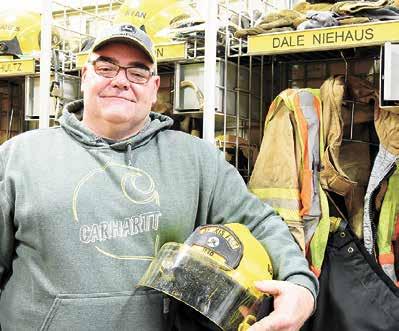
Niehaus also farms 800 acres. Sometimes, his pager goes off in the middle of eldwork.
“I’ve had to shut off the tractor and go up to the re hall,” Niehaus said. “I have a truck or a four-wheeler nearby so that I can jump in it and get up there.”
Niehaus usually begins morning chores between 4:30 and 5. There are times he is on
Kenton and Bobby Jo, and his parents, Andrew and Jennifer, own the farm.
Holle and his three younger siblings are the fth generation on the farm.
The Holle family milks 800 Holsteins three times a day in a 36-stall rotary parlor. They also raise their calves on-site.
Earlier this year, after the then-senior’s hockey season, Holle decided to run for a seat on the Legislature.
“I didn’t want to do anything in politics growing up,” Holle said. “I wanted to go to college, get a degree, nd a job and maybe come back to the farm; I was undecided about life.”
However, Holle saw what was happening to dairy farms in the state.
“We lose on average one to two dairy farms in North Dakota per year,” Holle said. “I realized we need to change something or there won’t be dairy farms here for the generations to come. I want other families to experience the same things that I grew up with – North Dakota tradi-
tional farm values and knowing the importance of dairy and how dairy farmers contribute to the health of people in North Dakota with their milk and other dairy products.”
The idea of running for ofce began to form.
“There was a two-week period where I was bouncing back and forth with the idea of running,” Holle said. “I had a lot of supporters with my family and friends saying things like, ‘You should do it,’ or, ‘I could really see you making an impact.’”
Holle has always been active on the family farm by milking cows, feeding calves, and helping with eldwork and harvest. Holle balanced farm work while also being a three-sport athlete.
In addition, Holle began what he calls a hobby business in 2020. About once a month, he made and sold gelato made with milk from the dairy.
“I haven’t really done it
November 26, 2022
a re call all night then comes home and walks directly to the barn.
“When we have structure res, we leave at maybe 10:30 at night and don’t get done until
4 or 5 in the morning,” Niehaus said. “We get back to the station, and the guys say to me, ‘Well, I guess it’s time to milk cows.’”

However, Niehaus is quick to give credit to his fellow re-
ghters and said they have busy schedules too.
“There are guys who have other jobs that begin at 5 or 6,” he said. “They don’t get any sleep then either. You have to juggle your family, work and the calls. Your sleep has to come last to make it all work.”

A shortage of recruits 21 years ago led Niehaus to volunteer.
“The small towns were getting smaller, so they didn’t have as many business people right in town to be on the department,” he said.
Niehaus was farming with his dad, Joe, and stepmother, Beth. He has since taken over the farm. In the past, the farm had been considered too far from the station for Niehaus to be a candidate for the department.
The lack of recruits changed that.
“They expanded the response time (to get to the station) to six minutes,” Niehaus
Dairy is in 96% of U.S. households using up 80% of what the United States produces. The rest is exported.
That is where the United States Dairy Export Council comes in.
Krysta Harden is the U.S. Dairy Exports Council president and CEO.
“If you look at exports, there is no way that you can’t be excited about what’s coming,” Harden said. “Somebody is going to meet the demand. I think it should be the U.S.”
PHOTO SUBMITTED Dawson Holle will be sworn in Dec. 2 to the North Dakota Legislature for House District 31. The 18-year-old grew up on Northern Lights Dairy near Mandan, North Dakota. Turn to HOLLE | Page 7 MARK KLAPHAKE/DAIRY STARwww.dairystar.com
ISSN Print: 2834-619X • Online: 2834-6203
522 Sinclair Lewis Ave.
Sauk Centre, MN 56378
Phone: 320-352-6303
Fax: 320-352-5647
General Manager/Editor
Mark Klaphake - mark.k@dairystar.com 320-352-6303 (ofce) 320-248-3196 (cell) 320-352-0062 (home)
Ad Composition - 320-352-6303
Nancy Powell
• nancy.p@dairystar.com
AgDairy marketing specialist Robin Schmahl expects Class III milk prices to remain steady with little change expected in milk production or consumer demand. “Higher demand probably isn’t going to happen because of the current economic situation, and it will take a while before milk production declines,” Schmahl said. “Dairy producers need to take a hard look at this market and when there are opportunities to protect prices, do some marketing or sign up for (Dairy Margin Coverage); they need to embrace those things.”’
Inc. Chair Marilyn Hershey participated in the United Nations Climate Change Conference in Egypt. “We are proud of U.S. dairy producers’ progress and leadership thus far,” Harden said. “But, we know we can do more.”
USDEC and DMI participated in forums on sustainable dairy production during the COP27 conference.
InsiderKaren Knoblach
• karen.k@star-pub.com Annika Gunderson • annika@star-pub.com
Editorial Staff
Tiffany Klaphake - Assistant Editor 320-352-6303
• tiffany.k@dairystar.com
Maria Bichler - Assistant Editor maria.b@dairystar.com • 320-352-6303
Danielle Nauman - Staff Writer 608-487-1101
• danielle.n@dairystar.com
Stacey Smart - Staff Writer 262-442-6666 • stacey.s@dairystar.com
Abby Wiedmeyer - Staff Writer 608-487-4812
• abby.w@dairystar.com
Grace Jeurissen - Staff Writer 320-352-6303 • grace.j@star-pub.com

Jan Lefebvre - Staff Writer 320-290-5980 • jan.l@star-pub.com
Taylor Jerde - Staff Writer 507-403-1680

• taylor.j@star-pub.com
Consultant
Jerry Jennissen 320-346-2292
Main Ofce: 320-352-6303 Fax: 320-352-5647
Deadline is 5 p.m. of the Friday the week before publication Sales Manager - Joyce Frericks 320-352-6303 • joyce@dairystar.com
Mark Klaphake (Western MN) 320-352-6303 (ofce) 320-248-3196 (cell) Laura Seljan (National Advertising, SE MN) 507-250-2217 • fax: 507-634-4413 laura.s@dairystar.com

Jerry Nelson (SW MN, NW Iowa, South Dakota) 605-690-6260 • jerry.n@dairystar.com Mike Schafer (Central, South Central MN) 320-894-7825 • mike.s@dairystar.com
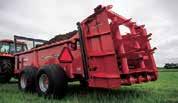

Amanda Hoeer (Eastern Iowa, Southwest Wisconsin) 320-250-2884 • amanda.h@dairystar.com
Megan Stuessel (Western Wisconsin) 608-387-1202 • megan.s@dairystar.com
Kati Kindschuh (Northeast WI and Upper MI) 920-979-5284 • kati.k@dairystar.com Julia Mullenbach (Southeast MN and Northeast IA) 507-438-7739 • julia.m@star-pub.com
Bob Leukam (Northern MN, East Central MN) 320-260-1248 (cell) bob.l@star-pub.com
The deadline for news and advertising in the Dairy Star is 5 p.m. Friday the week before publication.
One year subscription $40.00, outside the U.S. $200.00. Send check along with mailing address to Dairy Star, 522 Sinclair Lewis Ave., Sauk Centre, MN 56378.
Our ad takers have no authority to bind this newspaper and only publication of an advertisement shall constitute nal acceptance of the advertiser's order.
Letters and articles of opinion are welcomed. Letters must be signed and include address and phone number. We reserve the right to edit lengthy letters. The views and opinions expressed by Dairy Star columnists and writers are not necessarily those of the Dairy Star / Star Publications LLC.



The Dairy Star is published semi-monthly by Star Publications LLC, 522 Sinclair Lewis Ave., Sauk Centre, MN 56378-1246. Periodicals Postage Paid at Sauk Centre, MN and additional mailing ofces.
POSTMASTER: Send address changes to Dairy Star, 522 Sinclair Lewis Ave., Sauk Centre, MN 56378-1246.
During a time of high commodity prices, rising land values and government payments, a percentage of farmers became complacent. Virginia Tech professor emeritus David Kohl made that point during the National Bankers Conference in Omaha, Nebraska. “You’re going to have a certain set of customers that are going to burn through working capital, liquidity and their equity, but you’re going to have another set of customers that will put prots on the table, build liquidity, build equity and they’re going to grow,” Kohl said. In this time of extreme volatility, Kohl said commodity prices could drop quickly. That makes it more important for farmers to know their breakeven costs and manage risk. The geopolitical environment can make changes in an instant. “Whether it’s China, the United States or the Federal Reserve, they’ll ip the switch, and when change happens, it will happen very, very quickly,” he said.
A delegation led by U.S. Dairy Export Council President and CEO Krysta Harden and Dairy Management
For the past two years, President Biden has been in the Oval Ofce and the Democrats had the majority in the House and Senate. Republicans took control of the House in the election. Public policy consultant and lobbyist James Callan said this scenario will inuence the legislative agenda. “I think it will be difcult for the administration, if not impossible, to get anything major done.” If the Republicans win the majority in Congress, the chairmanship of the House Agriculture Committee would shift from current chairman David Scott of Georgia to G.T. Thompson of Pennsylvania. Callan believes Thompson would change the direction of the committee. “His priorities would be on dairy, forestry, nutrition from an oversight perspective and crop insurance,” Callan said. “Mr. Scott has
By Don Wick Columnist

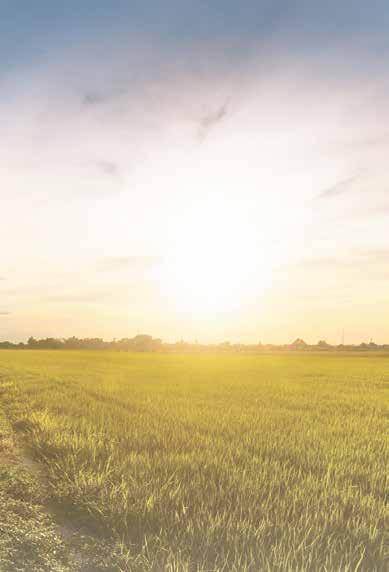

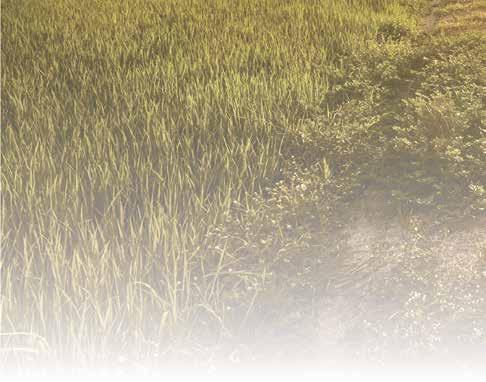




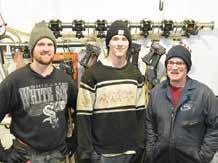



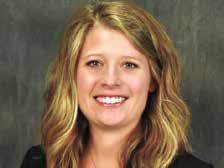
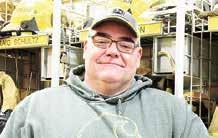





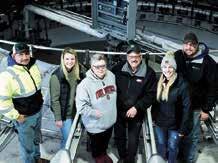












focused on climate, racial equity and Southern commodities so I think there will be a signicant difference in their approach and priorities.” Thompson has already discussed an ambitious timeline for the farm bill, completing the legislation before its expiration at the end of September. Callan leads a public policy rm in Washington, D.C. and represents Midwestern farm groups.


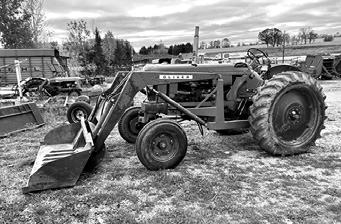

It was a winning strategy for the incumbents across the three-state area. In Minnesota, House Agriculture Committee members Michelle Fischbach, Angie Craig and Brad Finstad were reelected.


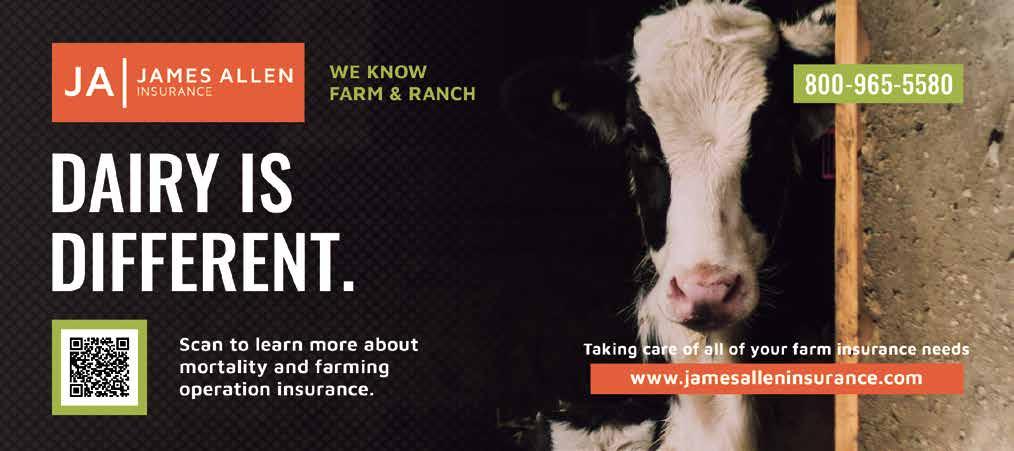
Walz wins another term Minnesota Gov. Tim Walz has been reelected. The incumbent beat Republican challenger Scott Jensen with a margin of 52% to 44%. Jensen had the majority of the vote across most of outstate Minnesota, but it was not enough to overcome Walz’s lead in the Twin Cities and metro areas like Duluth, Rochester, Mankato and Moorhead.
A day after the election, Minnesota Gov. Tim Walz sat down with commissioners and state agency heads. Minnesota Agriculture Commissioner Thom Petersen said the administration is hitting the ground running and mapping out the next four years. “It’ll be a little different with a Democratic House and a Democratic Senate but with very close numbers,” Petersen said. “For agriculture, we’ve been able to pass bipartisan bills for the past four years I’ve been commissioner, and we hope to see meaningful investments in agriculture.” Walz was scheduled to be at the AgriGrowth annual meeting to deliver his State of the State of Agriculture address but shared video greetings instead.
There are 68 new legislators coming to St. Paul in January. “One-third




of the legislature is new, and when you add to that the people who won in 2020, which was about 20% new, you’re almost up to 50% that nobody’s actually lobbied, engaged with or met with in person,” said Blois Olson, political analyst. The House committee hearings were done remotely during the coronavirus pandemic. Speaking at the Minnesota Ag and Food Summit, Olson said the Republican brand was damaged in this election. “If you can’t win in the suburbs in Minnesota, you can’t be a statewide majority party,” Olson said.

The new DFL majority elected Kari Dziedzic of Minneapolis as the Senate majority leader. State Sen. Mark Johnson, of East Grand Forks, will serve as the minority leader in the upcoming session. In the House, Melissa Hortman, of Fridley, was reelected as the speaker. The new majority leader is Rep. Jamie Long, of Minneapolis. Rep. Lisa Demuth, of Cold Spring, is the minority leader.
Nikki Deyle has joined the Minnesota AgriGrowth staff as its director of strategic engagement. Nikki and Nathan Deyle own and operate Stone Hill Farms near Browerville, Minnesota. Deyle previously worked for AgriGrowth from 2005-08.
The youth wellness program created by the dairy checkoff and the National Football League is called Fuel Up to Play 60. That answers our last trivia question. For this week’s trivia, what country started the tradition of putting up a Christmas tree? We will have the answer in the next edition of Dairy Star.
Don Wick is owner/broadcaster for the Red River Farm Network, based in Grand Forks, North Dakota. Wick has been recognized as the National Farm Broadcaster of the Year and served as president of the National Association of Farm Broadcasting. Don and his wife, Kolleen, have two adult sons, Tony and Sam, and ve grandchildren, Aiden, Piper, Adrienne, Aurora and Sterling.
Consumers are becoming more aware of how dairy can be used, and marketing, research and awareness of the benets of dairy in a diet is driving more interest in dairy around the world, according to Harden.
“We work on incorporating dairy into cultural favorites as well,” Harden said. “You shouldn’t have to eat American food or diets to enjoy American dairy.”
About 80% of U.S. exports are ingredients and include whey, whey protein concentrate and skim milk powder. These products are commonly used for smoothies, health bars and protein powders.
“Demand is great,” Harden said. “There’s a growing interest, growing awareness in U.S. products among other countries.”

Harden said the biggest challenge as of late is shipping.

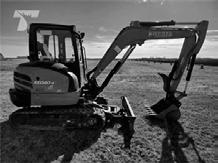



During the coronavirus pandemic, many Americans turned to online shopping and therefore often buying foreign products. Harden said there was so much demand for goods coming into the U.S. that it was often cheaper for ships to unload their goods and turn around empty than to wait for U.S. goods to be loaded.



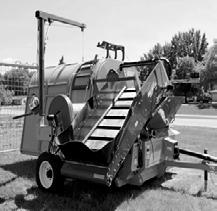


“The inbound, imports, were so great,” she said.
Moving products by rail and truck has also been a roadblock to exporting U.S. dairy products.

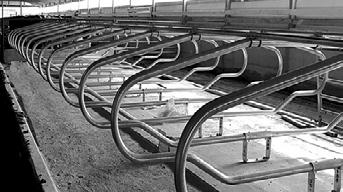

The Ocean Shipping Reform Act has eased some of the barriers.

“It is better,” Harden said. “It’s not xed, but it is better right now.”

Ination is also impacting the potential for countries to afford American goods.
“The pandemic really taught us all lessons that we are going to deal with these types of issues in different ways, and we don’t need to be dependent on just one country or one region,” Harden said.
The biggest competitors of the U.S. dairy industry are New Zealand and Europe, Harden said. But, New Zealand and countries in Europe are land locked, giving the U.S. the advantage because of its size and space.
“We know what we’re doing here, and we know how to do it very well,” Harden said.
Harden said the biggest importer of U.S. dairy is Mexico. Harden said the two countries have a good working relationship.
Other countries include China, Southeast Asia, Japan and Korea.
Harden said the U.S. is seeing consistent growth of imports to South America, the Middle East and northern Africa.
The USDEC opened an ofce in Singapore in 2020 and serves the 16 countries which make up Southeast Asia. The center includes a test kitchen to help nd new ways to use dairy products in the area’s cuisine.
China, because of its population, has been a key market for U.S. dairy.
Harden said the Chinese government has recommended consumers use more dairy in their diets. The USDEC has noticed an increase in products such as butter and whole milk powder.
“We work with local cultures to make sure it is incorporated into diets that just need fortifying,” Harden said.
South America, especially Chile, has been steadily increasing their imports of U.S. dairy.
“Our strategy has been to be as diversied as possible,” Harden said.
One product seeing an increase in demand is cheese. About 3,000 varieties of cheese are exported, and artisan cheeses are popular. Chile has the highest gross domestic product in South America; therefore, consumers have disposable income and appreciate U.S. cheese, Harden said.
“The Middle East is also very interested in our cheese,” Harden said. “That’s all they want to talk about.”
When the USDEC was created 27 years ago, the U.S. was exporting 2%-4% of what the country produced. Today, the U.S. exports 18% of its’ total production.
Looking ahead, USDEC expects the focus on health and wellness to continue. With dairy products being nutrient dense, the USDEC sees this as an opportunity to promote American dairy.
Harden said pizza is gaining in popularity across the globe bringing with it a demand for cheese. And, USDEC is working to nd ways to encourage other countries to incorporate dairy into their mainstay foods.
“Nobody works harder in the world than the dairy farmer,” Harden said. “The future is really bright for U.S. dairy. I would say to dairy farmers that the future is really for yours to drive. The world wants our products and needs our products. We can help nourish a very hungry, food insecure world.”
since I was running (for ofce), but it actually had gotten a lot of traction,” Holle said. “People are kind of mad at me because I haven’t made it for a while. Hopefully they will forgive me because of the campaign.”
After weighing whether or not to run for ofce, running won.
“I had the overwhelming feeling that if I didn’t run, I would regret it,” Holle said. “The worst thing that could happen is you lose, but you still get your name out there for future races, so I decided to give it a shot.”
However, Holle needed to get on the ballot rst, which required 200 signatures on a petition. It was already April, and the primary was set for June 14.
“It was actually not as hard as I thought,” Holle said. “People didn’t really know who their representatives were; we had redistricting at the time. People liked my agriculture background and the ideas I wanted to bring to the Legislature, and they said, ‘I’ll back you.’”
Those ideas are many, and Holle is straightforward when stating them. One focus he has is on protecting the dairy industry.


“I want to bring forth a bill that says that milk can only be called milk if it comes from (dairy animals),” he said. “Almond milk and other (non-dairy) milk needs to rebrand itself or have special labeling. A lot of people think they are drinking milk, but they are not getting the same nutritional values of milk.”
Another concern Holle has is for the people of the Standing Rock Sioux Reservation, which is located in District 31. Holle wants to make sure its citizens have equitable access to voting.
“We only have one voting site on that whole reservation, and the reservation spans upward of a hundred miles,” Holle said. “I want to put more voting sites there so that they are more accessible for people.”
Holle said he would also like to bring a bill forward to require students to recite
the Pledge of Allegiance while at school.
“There was a controversy in Fargo where the school board got rid of the Pledge of Allegiance,” Holle said. “We need to protect the pledge for veterans, so we remember who fought for us and our freedom that we have today.”
Protecting North Dakota’s export industries of coal and oil as well as supporting the Second Amendment and pro-life initiatives are also important to Holle.
His goals and ideas have resonated
with people in his area. Of the three Republicans running to become candidates for two House seats in District 31, Holle and incumbent Karen Rohr won.
“I honestly must say that I was shocked at the number of people who said they would support me, and they actually did,” Holle said.
Although it was a victory for Holle, it brought on a few concerns. His win ousted another incumbent Republican, Jim Schmidt, who was a colleague and friend
of Rohr. Also, Holle said people in the district thought Holle should wait until a retirement created an open seat.
Holle wondered what his overall reception might be.
The answer came when Rohr offered to join forces with Holle to defeat Democratic candidate Mike Faith.
“Karen and I worked together,” Holle said. “We decided we wanted to show a unied base, so we went door knocking together in every city in our district.”
Their teamwork paid off.
“People liked the approach we were showing, from someone young with an agriculture background and from a person who has experience in the Legislature and could guide the younger legislator.”
Friends and family held a watch party the night of the election at Seven Seas Bar and Grill in Mandan.
“It was probably about 11:30 at night when we realized we (he and Rohr) won,” Holle said.
Holle expected to feel exhilarated, but he felt something else.
“It was kind of an overwhelming feeling because you put in all that work for the past ve months,” Holle said. “It paid off, and you get to see that people want you in, but you realize that now the real work starts from here.”
He is not sure whether or not politics will be a mainstay in his future. Holle has chosen to minor in political science; his major is business management. Whatever his future, Holle said that growing up on a dairy farm helped prepare him for this position as a representative.
“A special quality that agriculture gives a person is grit,” Holle said. “Time is almost irrelevant on a farm because your work day is mostly when the sun comes up to when the sun goes down. I will put in the long hours and the grit to make sure that my bills get across the nish line or my voice or my constituents’ voices are heard because I have the determination to get things done.”
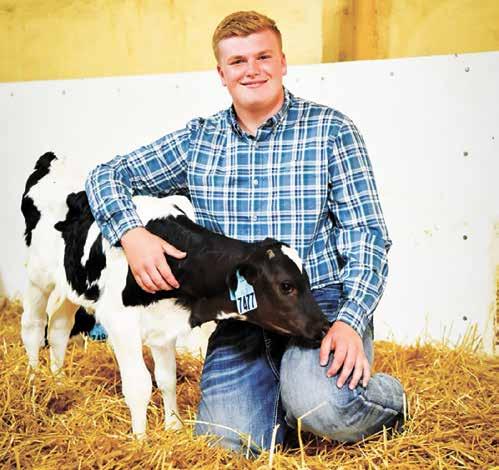
He

“What kid doesn’t want to be on the re department, right?” Niehaus said.
When Niehaus joined in June 2011, he was scheduled to begin his training that fall. Then on Sept. 11, the world changed. Within one morning at the World Trade Center, more than 300 reghters died in service along with other safety and rescue personnel. The images were everywhere in the media for months afterward.
“I thought, ‘What did I get myself into?’” Niehaus said. “It really made me think, do I really want to be here? But, I stuck with it, and it’s been great.”
Training changed in the wake of 9/11. For instance, a system for identifying reghters was put in place in case they were injured beyond recognition. Fireghters now have two metal tags with their identication number on them. If the re is big enough where more than one unit is called in, reghters pin one tag to their clothing and give one tag to the lead reghter before going into a burning building.
“That’s for accountability,” Niehaus said. “It all stems back to 9/11. The departments all had numbers but not the individual re ghters.”
Niehaus’ has No. 1139.
“The only other way (to identify a burned reghter) would be through DNA testing,” he said.

Niehaus went through 160 hours of medical and rst responder training along with two nights per week for four months of training in reghting and hazmat. Because Niehaus was the only one joining the Osakis department at the time, he drove to Parkers Prairie for training.

“I tried to get the chores done before I went,” he said.
Niehaus said he appreciates the support he has had all along to make his service possible.
“I’ve always had special people in place when I receive calls,” he said. “I’ve been blessed that way.”
In the beginning, his dad, sister and stepmother would help cover for him.
“When I was on the farm working with my dad, he understood,” Niehaus said. “He didn’t always like it when I left in the middle of chores or when in the eld, but he respected it. Other family and friends stepped in too.”

Today, he and his wife, Rachel, have six children. Niehaus also has an adult daughter who lives away from home. His oldest at home, Clayton and Garrett, are among those who step in for him now.
Like Niehaus did as a child, his children look up to reghters.

“It’s not just (toy) John Deere tractors at home,” Niehaus said. “It’s yellow retrucks. You’ve gotta have yellow. Sometimes we have to go online to nd them.”
The Osakis department has yellow trucks.

“They’re starting to change colors,” Niehaus said. “The red ones are used now for parade trucks. They’re nding out that yellow is a stimulant to the eye as a caution to slow down.”


Although Niehaus said he is glad he joined more than two decades ago, he and
his fellow reghters have to deal with the aftermath of difcult calls.
“That’s part of it when you live in a small town,” Niehaus said. “It can be people you know, so that can make things even tougher.”
As a farmer, barn res also feel especially personal.
“You go to a barn re and see a lot of dead cows,” Niehaus said. “It’s gut wrenching to see. The barn is engulfed in ames, and there is not much you can do. You feel the loss, but you have to do what you can do to put the re out.”
Niehaus said he became better equipped to leave calls at the department and focus on family and work again once he was home.
“You learn,” he said. “There are people who can help you if you can’t deal with it. For the most part, the guys on the department are the ones who help you get through it.”
Everyone on the team steps up to do whatever is needed and is trained in all the jobs of reghting.

“Generally, I’m one of the guys that goes into the re,” Niehaus said. “I’d rather do that than be a pump operator. It’s very stressful, but I’m more of an adrenaline junky, I guess.”
He has great respect for his fellow reghters.
“They really matter,” Niehaus said. “You all go in with the same mindset. Let’s get this re out or let’s get this accident taken care of, and we do what we have to do to get back (to the station) safely and back to our families.”
He also sees some similarities between dairy farming and reghting.
“It’s a lot of the same things,” Niehaus said. “If something goes wrong, you drop to a plan B or maybe even a plan C. Things go bad, things break, you have bad weather. You adjust to that and have a different plan in farming and in the re department.”

Josie Rozum was one of the rst students to complete Midwest Dairy’s Dairy Experience and Agricultural Leadership Program.
Rozum dairy farms with three of her siblings and her parents at Takes Family Farms near Ely, Iowa. They milk 120 Holsteins and also run Dan and Debbie’s Creamery in Ely.
“Because of our creamery, I probably deal with consumers more than the average dairy farmer,” Rozum said. “One thing I loved about the DEAL program is that it gave us a look into consumers in a different way and coached us in how to educate them about what we do. There’s a big gap between consumers and producers, and I loved getting the tools, resources and coaching that we need to do a good job of telling our story.”
Midwest Dairy launched DEAL in 2021 to help farmers, age 40 and younger, become effective spokespeople for the dairy industry. Rozum completed the program in the summer of 2021.
With Rozum’s class having completed the program, and the second group starting up, program facilitators and participants are seeing positive results.
Jenna Finch is the agricultural affairs manager for Midwest Dairy. She plans and oversees the DEAL program by arranging events and reaching out to the group with updates and learning opportunities.

“We were trying to ll a need for young, emerging dairy leaders who wanted to be engaged with Midwest Dairy and learn more about dairy checkoff and how we’re applying those resources to build trust in, and demand for, dairy,” Finch said. “They also wanted to grow their leadership and advocacy skills.”
The 18-month program helps participants forge relationships with their peers and others in the industry, learn how to successfully engage with consumers and the media and better understand the dairy checkoff.
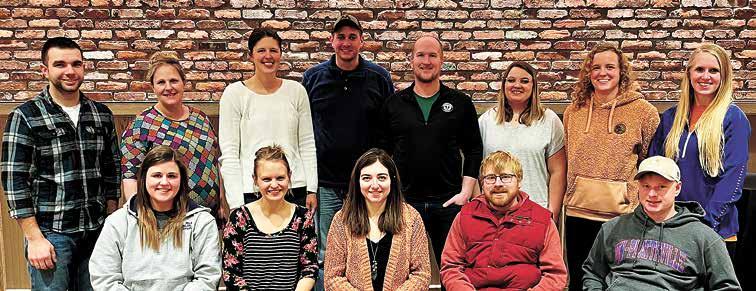
“Participants love the networking that takes place within the program,” Finch said. “I consistently hear back from the group that it’s so nice to meet so many great people from different areas and learn from them too.”
For Rozum, the program has helped her navigate difcult questions from consumers.
“One of the toughest questions consumers ask is about separating the mom and baby,” Rozum said. “To others, that seems like an awful thing to do, but we have good reasons for doing that as a dairy farmer, so to be able to gracefully and tastefully answer those kinds of questions, and still be respectful to those who don’t understand the dairy industry, is really important.”
Midwest Dairy brings in speakers and groups from the industry and teaches social media and communication skills to build condence in representing and advocating for all things dairy. Although the core lessons remain the same, Finch and her team have been adding new opportunities and ne-tuning lessons based on feedback from DEAL students.
To select dairy farmers for the program, a committee looks through applications received from the 10-state region of Midwest Dairy and selects a class of 15. Midwest Dairy pays for the program and grants stipends to participants for stepping off the farm for the sessions. The students meet in person for three sessions over 18 months for a total of 11 days. Between sessions, participants do assignments aimed to build knowledge, condence and communication skills.
Cole Hoyer is a member of the current class, which has completed two of the three sessions. He and his wife, Katie, along with her parents, milk 120 cows on their dairy near Estelline, South Dakota.
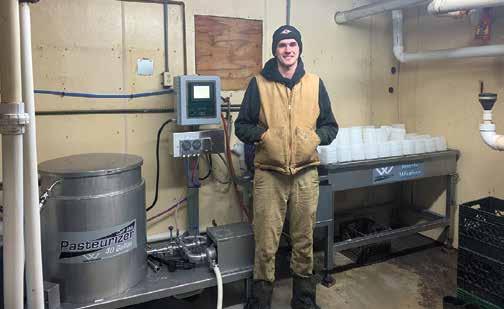
Hoyer applied for DEAL when a local dairy farmer suggested doing so. Hoyer said he is looking forward to the next DEAL assignment.
“It is to get involved with some type of promotion, whether that’s hosting people on your farm to educate them about dairy, going to someone else’s farm, working at some event Midwest Dairy is involved in – something to help promote dairy,” he said.
“There’s a lot of options.”
Hoyer said he appreciates what he is gaining through DEAL. His last session focused on how to create a social media presence for a farm and present on social media in a positive way.
“I learned that I have a lot to learn, especially on the social media side of things,” Hoyer said. “I enjoy interacting with consumers, but it’s also intimidating in some ways, especially nowadays with the internet the way it is. You can say something, and seconds later people can have it up on their phones.”
DEAL sessions also connect farmers to people they might not be aware of in the industry.
A recent presenter was from GoodSport, which makes a sports drink from ultraltered milk.
“I had never heard of that company or the drink,” Hoyer said. “I wish
the general farming population could know how much Midwest Dairy is doing to get milk consumed and used so that we can keep having a market and keep being able to do what we love.”
Lindsey Borst is also a member of the current DEAL class. A veterinarian and a calf and heifer nutritionist by trade, Borst helps at Borst Family Dairy near Rochester, Minnesota, which milks 230 cows. The farm is owned by Borst’s husband, Kevin, and his brother, father and uncle. Borst said she appreciates opportunities that have come her way through DEAL. Recently, Finch asked her to be on a discussion panel that Midwest Dairy is sponsoring at the Dairy Girl Network
national conference.
“I absolutely would not (have said yes), so DEAL has opened up doors for me to doing new things and given me condence to do so and to continue with social media,” Borst said. “It’s also given me more motivation.”
Midwest Dairy plans to open up applications for the third DEAL class in fall 2023.
Finch said she is excited to see the program continue.
“I feel so lucky that I get to be part of this program and work with these energetic, fun emerging leaders,” Finch said. “I’m in awe of how strong this industry is and how bright the future is.
“We began looking at a bottle washer to keep bottles cleaner and eliminate an extra job. After seeing the option to purchase the bottle washer and pasteurizer combination, we started to look at its benefits. Once we calculated what we would save by not buying bags of milk replacers, it was an easy decision to add the pasteurizer. Since installing the new system of the bottle washer and pasteurizer combination the calves drink better and are healthier.”Owen Murphy Murphy Dairy Farms Farley, IA
DEAL helps young farmers become advocates for industryPHOTO SUBMITTED Current students of Midwest Dairy’s Dairy Experience and Agricultural Leadership Program – Jessi Sayers (front, from le ), Stacy Rethman, Nicole Engelken, James Goldsmith and Ray Hildebrandt; (back, from le ) Cole Hoyer, Elle Tibor, Lindsey Borst, Kevin Borst, Dan Venteicher, Natalie Barka, Paige Roberts and Courtney Lintker – gather Feb. 24 at their rst session in Denver, Colorado. This is the second group of dairy farmers to go through the DEAL program, which helps young farmers become advocates for the industry. Jenna Finch Midwest Dairy


EDEN VALLEY, Minn. – What started as a goal for the eldest of six Gathje children also became the goal for the rest.
Over the span of a decade, Scott and Denise Gathje’s half-dozen children – Joe, Anne, James, Katherine, Greg and Jonathon – have achieved the American FFA Degree, the highest degree possible for the organization’s members.
The American FFA degree is achieved by less than 1% of FFA members.
Tracy Huhn began teaching agricultural education at Eden Valley-Watkins High School in 2008 and was the FFA advisor for all of the Gathje children.
The FFA chapter has grown to include three advisors, Huhn, Tyler Warren and Kayla Gratz.
“It made me proud to see all of them go all the way to get their American Degree,” Huhn said.
All of the Gathjes held the ofce of president or vice president with their chapter but each chose their own path in FFA. They competed in a variety of career development events and took classes of interest. Some went on to be regional ofcers; others attended the Washington Leadership Conference in Washington, D.C.

“It was pretty cool to see all of them go as far as they did,” Scott said.
Scott was in FFA but said it never crossed his mind to get his American Degree.
Denise said she enjoyed seeing her children grow and develop leadership skills. She said FFA allowed her children to practice skills of interviewing, writing, lling out applications and making connections that encouraged them to pursue other opportunities.
“They all enjoyed it,” Denise said.
The Gathjes milk 65 Holstein, Brown Swiss and Jersey cows. They farm 200 acres of alfalfa and corn and raise their youngstock. In addition to the cows, they also have a horse, ducks, sheep and chickens. Each of the Gathje children showed the various animals in 4-H.
For the kids, the relationship with FFA started in 2008 when Joe joined FFA as a freshman. Huhn encouraged Joe to begin a supervised agricultural experience and obtain the State FFA Degree.
Joe said he enjoyed his time in FFA and was involved in dairy evaluation, dairy foods, helping with the chapter corn drive, helping with the chapter corn test plot and becoming a chapter ofcer.
“FFA was what I looked forward to,” Joe said. “It really helped carry me through school.”
After achieving the State FFA Degree, Huhn encouraged Joe to try for his American Degree. Joe agreed to apply.
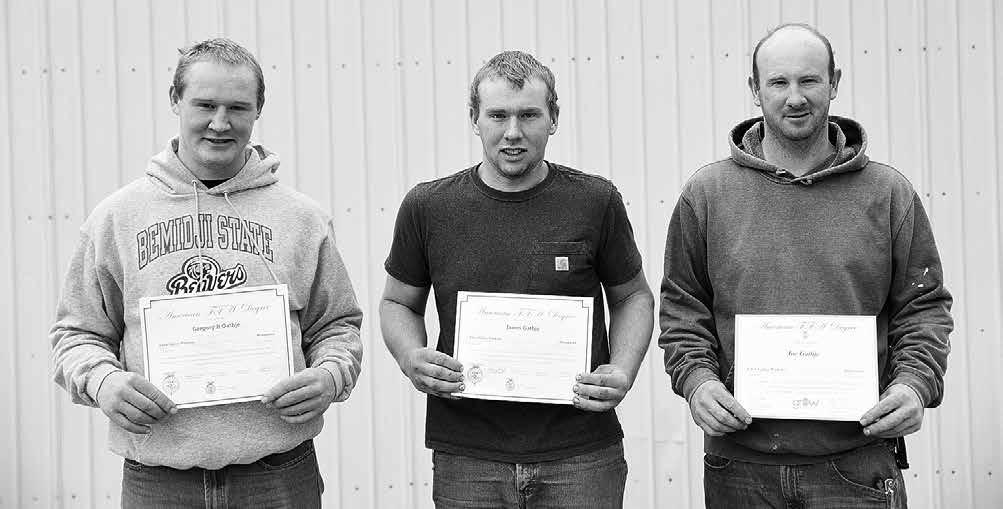
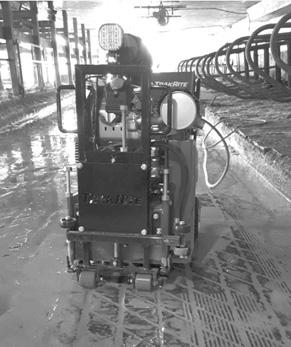
In 2012, at the 85th National FFA Convention and Expo in Indianapolis, Indiana, Joe walked across the stage to receive his American FFA Degree.

Joe went to college at South Dakota State University for agricultural science and now works at a cooperative, helps his parents on the farm and runs a manure pumping business on the side.
When Anne started high school, she too joined FFA, but she chose to be on the meat judging, dairy handling and prepared public speaking teams. Anne said she enjoyed her time in FFA so much that she chose to pursue an agricultural education degree at South Dakota State University. While in college, she decided to take what she learned in her business and accounting classes to form a career.
“I am currently working in accounting for Novita Nutrition, an animal nutrition company located in Aurora, South Dakota,” Anne said. “With the background and connections I have made in the agricultural industry, it has been fun to be growing my accounting career within the agricultural industry.”

After seeing his two older siblings meet the requirements and get their American Degree, James also set his sights on the degree. He had already met many of the requirements with his dairy production SAE, volunteering with his 4-H club and working on his parents’ dairy farm. James was involved on the dairy judging team, was a chapter and region ofcer, and attended the WLC
“I loved that I got to travel all over the Midwest and to WLC,” James said. “I was very grateful for that.”
James said because he had a positive experience while in Washington, D.C., he went to school at St. John’s University for political science and economics. While in college, James returned to Washington, D.C. for an internship.
“FFA has impacted me in so many ways,” James said. “The skills are very transferable to real life.”
James credits FFA for helping establish his skills in writing, job interviewing, leadership development and teamwork.
Katherine became the fourth of the Gathjes to get her American Degree and credits her active chapter and her advisors with spurring her on.
“The leadership experiences I gained in FFA gave me the foundation for my career,” Katherine said. “It gave me the good leadership and good communication skills I needed to succeed.”
Katherine now oversees the leadership development program for young professionals at the Kanas City Chamber of Commerce.
Unlike the rest of his siblings, when Greg joined FFA, he was in poultry judging and took classes in sh and wildlife. Greg said he never con-
sidered getting his American Degree until he walked across the stage at the Minnesota State Convention and received the State FFA Degree. Then, the American Degree became a possibility.
Greg said he enjoyed being in FFA with his friends and getting to know kids from other schools.
“FFA helped expose me to the career path I am on,” Greg said.
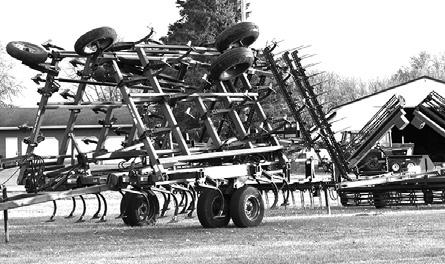








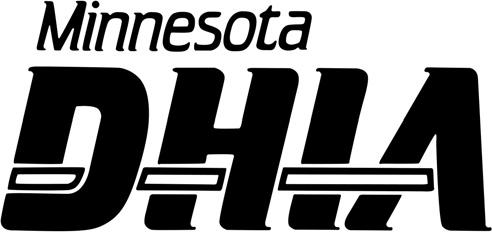








Greg is attending Bemidji State University and majoring in biology.
Jonathon also joined the poultry judging team. Additionally, he joined the parliamentary procedure team and helped on committees. For Jonathon’s
SAE project, he chose sheep entrepreneurship. He purchased two bottle lambs and raised them. Jonathon now has six ewes and one ram. Jonathon wanted to get his American Degree not only because the rest of his siblings did but because he felt it was easy to do once he got his State FFA Degree.

“It is a nice nal touch to my FFA career,” Jonathon said.
Jonathon attends Alexandria Technical and Community College for diesel mechanics and has a job lined up after his graduation this spring to work with Arnold’s Equipment in St. Martin.


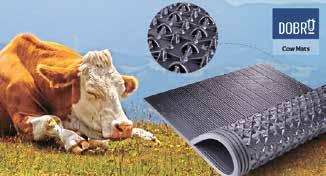
WISCONSIN DELLS, Wis. – Nick and Jackie Morse love macaroni and cheese so much that when looking to open a new restaurant in downtown Wisconsin Dells, they chose to build their entire menu around this one dish. A far cry from macaroni and cheese in a box, these entrepreneurs took a family favorite and turned it into a gourmet meal.
“We focused on quality and ways to expand on a classic dish,” Nick said. “We wanted to elevate a food that people are familiar with and make at home. To create an identity, I knew we had to make our macaroni and cheese from scratch.”
The idea was bold yet brilliant. Featuring cheese as the star ingredient, the Morses invented a culinary delight worthy of sharing with the rest of Wisconsin. Made and served in a cast iron skillet, the concept was unlike any other the state had seen before.
The Morses decided to call their restaurant MACS Macaroni and Cheese Shop and designed a logo in which the letter
C in the word MACS resembles a macaroni noodle. In 2013, the Morses opened their agship store.

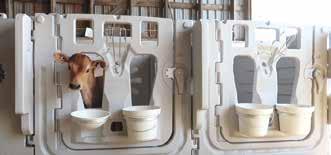

“The food here is not premade,” Nick said. “Every dish is built to order. Customers can also customize their creations.”

The dishes are called MACS. Crispy on the top and creamy on the inside, at the base of each is the cheesiest macaroni and cheese around. From there, every creation contains
the freshest ingredients, including chicken, pork, beef, onion, mushroom, broccoli or spinach, to name a few. The menu is lled with recipes for all kinds of palettes and avorful options to satisfy everyone’s inner child.
Serving fast, fresh, comfort food is what the Morses do best. Energized by tourism, these Wisconsin Dells natives seized an opportunity when they saw a prime location on the main strip become available. Jackie was
doing interior design work, and Nick was teaching at the time.
“We were looking to do something on our own, so we started brainstorming ideas,” Nick said. “We didn’t want a standard restaurant; we wanted something unique. We decided to stay focused on a single item and make it the cornerstone of our business.”
Food was a perfect t for Nick and Jackie, both of whom grew up in the restaurant indus-
try.
“We were making a lot of mac and cheese for our 1-yearold at the time,” Nick said. “We like it and know that lots of other people like macaroni and cheese too. It’s a food that transcends different age groups. Being in the heart of Wisconsin, we’re also in a good spot for mac and cheese. Doing something with dairy just made sense.”
Nick and Jackie experimented with ideas at home, making all kinds of macaroni and cheese recipes. It was a process of trial and error as they gured out which toppings made the best concoctions. Starting with 12 entrees, the Morses focused on quality ingredients and processes when building their menu.
Jackie designed their restaurant and gave it a rustic feel. A brick wall serves as an accent wall – a design element found in all MACS stores. Creating a place where people want to linger was the goal.
“A warm, inviting atmosphere is what we’re going for,” Jackie said.
MACS acquired an intense following, and the Morses opened their second restaurant almost a year to the day on the other side of town. From that point forward, a new MACS opened every year through 2019. In July, they opened their eighth location.

There are two locations in the Milwaukee area in Brookeld and Oak Creek, two in the Madison area, two in Wisconsin Dells, one in Green Bay and one in Appleton. All stores are owned by Nick and Jackie and are open every day from 10:30 a.m. to 9 p.m.
“We get lots of requests for different markets, but it has to be the right location at the right time,” Nick said. “We have a lot of out-of-state interest, but we’re not looking to franchise. Operationally, we want to keep it tight and grow closer to home without stretching ourselves too thin or hurting our product and brand.”
The family ties in downtown Wisconsin Dells are strong; the building once belonged to Jackie’s grandparents who owned The Patio restaurant.
“We get customers from all over, and this is a nice showroom,” Nick said.
The Morses staff and monitor every location and have 120 to 170 employees across all shops. The number of employees varies by season.
“We travel a lot from store to store and are fortunate to have a close-knit management group,” Nick said.
Now, MACS offers 18 macaroni and cheese dishes along with two monthly specials. The most popular creation on the menu is the chicken bacon ranch MAC featuring cheddar, mozzarella, chicken, bacon and ranch dressing. The loaded baked potato MAC is a close second containing cheddar, mozzarella, baked potato, bacon, sour cream and chives. The original MAC smothered in cheddar and mozzarella is also a crowd pleaser.
The Morses marry popular food entrees into their mac and cheese like tacos in their taco MAC featuring pepper jack, mozzarella, pico de gallo, seasoned ground beef, cheddar, sour cream, guacamole and tortilla strips. Their cheeseburger MAC with its cheddar, mozzarella, ground beef, pickles and dressing toppings satises a craving. In addition, six melts or specialty grilled cheese sandwiches can be found on the menu.
“We offer salads, too, to balance out our offering,” Nick said. “There’s something for everyone at MACS.”
Cheese, milk and butter are the soul of MACS, which takes a hands-on approach to food preparation. Chicken is shredded on-site, and the Morses’ cheese sauce is made from scratch with over 25,000 gallons made year to date. The sauce starts with their homemade roux, which is a mix of butter and our. They then add milk, proprietary seasonings and a combination of shredded cheeses as it thickens.
“The cheese sauce is Jackie’s dad’s recipe, and it’s a big point of pride in what we do,” Nick said. “Very few of our
ingredients come out of a box. We pride ourselves in doing a lot of baking and cooking. Our staff works hard to execute this, and we appreciate what they bring to MACS. Service is important to us, and we keep kitchen and order taking duties separate.”
So far this year, MACS stores have used 33,000 pounds of butter and more than 150,000 pounds of cheese.
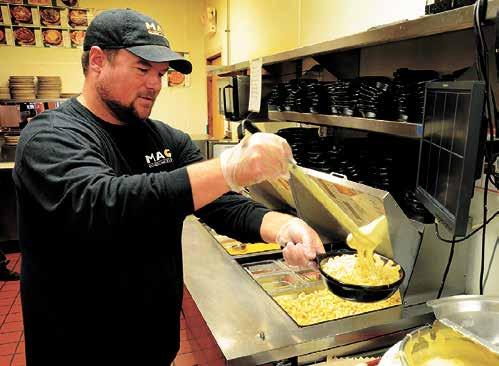
“The dairy industry means everything to our business,” Nick said. “We started with a simple concept to hang our hat on and make our identity. But it’s not just about me and Jackie. MACS is part of Wisconsin, which is where we want to grow. The mural in every shop tells our story.”
Featuring a cow, a barn, the shape of the state of Wisconsin and other agricultural symbols, the mural depicts the essence of MACS’ foundation.
“We felt more condent in being able to specialize with Wisconsin’s history in the dairy industry anchoring us,” Nick said. “I knew we needed quality behind our dishes.”
This past summer, the Morses opened Huckleberry’s Ice Cream and Bakery next door to the downtown MACS location. The elegantly decorated dessert venue is connected to MACS, making it easy for customers to grab both salty and sweet food in one visit.
“It’s the best of both worlds – lunch and dessert,” Nick said. “Jackie designed Huckleberry’s, and it has great curb appeal. MACS has gained customers who originally came for the ice cream.”
Purchased from different providers, Jackie is hoping she and Nick can make their own ice cream one day. The couple now has three children – Julian, Olivia and Max – and raising a family while running the MACS restaurants keeps Jackie busy to the point that she no longer does interior design for other clients.
Filled with personal touches, the Morses go out of their way to make dining at MACS a memorable experience. From food presentation to the food itself, the Morses spare no detail. For example, MACS uses real butter on its toasties –the little pieces of toasted bread served with each mac and cheese dish.
“It’s painstaking, but it makes a difference in the quality we provide,” Jackie said.
MACS is a cozy place to get away from it all while escaping into a skillet of mac and cheese bliss. People walk away content after eating cuisine that warms the heart. As they continue to specialize in the one dish their customers keep coming back for, Nick and Jackie keep their eye on the right opportunity for the next location.





PULSNEXUS G2 Monitoring System
Keeping full-time watch on hose detachment, damage, & blockage; & the proper
PULSNEXUS offers:
•Adaptation to any system

•Pulsator control & performance
SCANNEXUX G2
Stand-Alone Milk Meter
this solution is not a milk yield indicator— there’s no need to lift or restrict milk to be accurate. The Stand-Alone Milk Meter offers:

•Adaptation to any system
•Pulsator control & performance
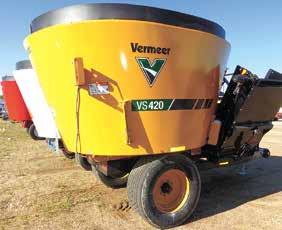





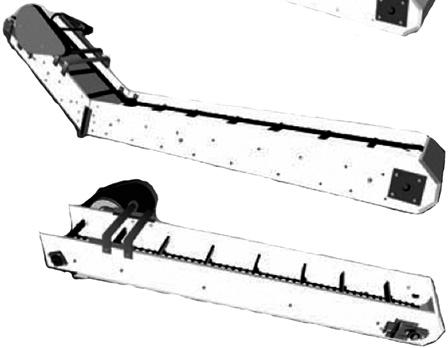

























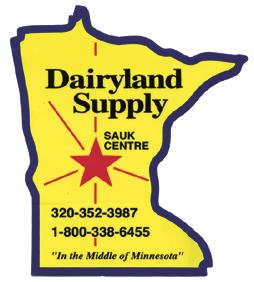



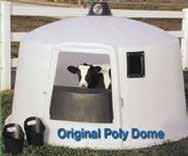





Brent Havlik Norwalk, Wisconsin Monroe County 54 cows
What are you thankful for this year? We are glad to live in a time when a family can farm together and still make a living. We are thankful to God for health, a family who loves and lives for the Lord and a growing family. We are expecting our rst grandchild in a couple weeks.
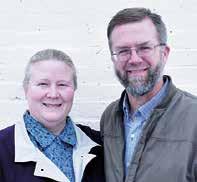
Describe a moment this year that made you grateful. It is difcult to come up with just one. Our creamery has been supportive, and our feed company works hard to meet the dairy goat nutritional needs. All around, it has been a good year.
Who is someone in your life you are thankful for? Our parents. They have raised us to be strong and grateful and to never take our faith or blessings for granted. They also taught us to work hard and to creatively problem solve.
How do you show appreciation for the people you work with every day? With words of sincere gratitude. Also, by getting our hands dirty together and working alongside them. We are all in this together.

How do you celebrate Thanksgiving? By cooking a homegrown meal with a mixture of American and heritage foods. Then, sharing in a prayer of gratitude for God’s provisions and taking the time to count our many blessings.
Tell us about your farm. We are glad to be stewards of 120 acres of which 90 are tillable. They are planted into hay which supplies our goats’ hay needs and a little more to sell, which helps offset our feed costs. We sell young bucklings and some doelings each year. We raise our replacement dairy does. We ship our milk to Stickney Hill Dairy Inc. out of Cold Spring, Minnesota.
What are you thankful for this year? I’m thankful I’m still in business. With the price of inputs so high, it seems like there's no room for error, and things better go good. I’m also thankful for a good crop year that provided plenty of hay. I’ve got a family that supports me and helps me when I need it. We have a 2-year-old grandson who comes to the farm so that is encouraging.
Describe a moment this year that made you grateful. I enjoy spending time with family, and everyone is healthy and happy. We had no major weather disasters this year, no ooding and had timely rains we needed.



Who is someone in your life you are thankful for? My wife, Sarah, because she has always been there to support me. She’s got a job too, which helps because there are times we wouldn’t survive with just the farm income. I am also blessed with good neighbors: the Lelands, Randy next door, and Dawn and Chad Powell. They are kind of like extended family. It’s so good to have good neighbors who are willing to help.
How do you show appreciation for the people you work with every day? Thanking them for their help. Everybody is busy and has plenty to do on their own.
How do you celebrate Thanksgiving? We get together as a family at our house. We get up and do chores early to get home for dinner. We play games after the meal. Our grown kids return home to celebrate with us.
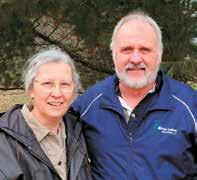
Tell us about your farm. We are an organic dairy with about 60 head. I started farming later in life, so I rent the farm. We cover 250 acres and ship our milk to Westby Cooperative Creamery.
Norm and Camille Zacharias Hinckley, Minnesota Pine County 70 cows

What are you thankful for this year? For our wonderful family of ve children, who have grown to be humble, young adults. A beautiful, peaceful place to live and plenty to eat. A bountiful corn silage harvest in spite of the drought.
Describe a moment this year that made you grateful. My husband and I had a minor accident with the all-terrain vehicle while working cattle this summer. We are grateful no one was seriously injured.
Who is someone in your life you are thankful for? Good neighbors who always have our back and help one another out. They are always willing to help us with an extra set of hands or with machinery maintenance. They have our back, and we have theirs.
How do you show appreciation for the people you work with every day? By working together and helping one another. When we all work together, we get done sooner and more efciently.

How do you celebrate Thanksgiving? Our family gets together with turkey and dressing and all the trimmings. All ve of our children come home to our house, even our two boys who live in South Dakota.
Tell us about your farm. Norm started dairying in 1988 on his parents’ farm, which we eventually purchased. We built a milking parlor in 2006. We raise our heifers, hay and corn silage. Our ve children grew up working on the farm and all have an excellent work ethic. One son lives at home and works on the farm. One daughter lives at home and has a job in town. She helps on the farm. We ship our milk to Burnett Dairy Cooperative.
Star Blends has been helping Midwest farm families by providing, high-quality feed, dairy nutrition, and commodity contracting for more than 20 years. Our state of the art mill can accuratelyblend anything from a custom pre-mix to complete feed, in balancing diets, or work with your private nutritionist or dairy consultant.
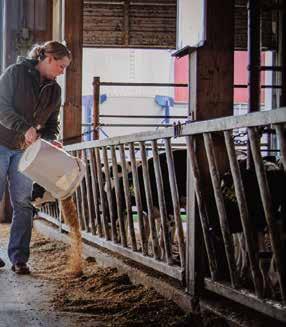 Rod and Barbara Lindell Browerville, Minnesota Todd County 150 goats
Rod and Barbara Lindell Browerville, Minnesota Todd County 150 goats
What are you thankful for this year? I am thankful for the improvements we've made to feeding the cows and the heifers. We made a double-sided feeding lane for the cows and poured cement and installed headlocks for the heifers; it has made feeding easier for everyone. I am thankful that my family is happy and healthy. I am also thankful to always have family around on the farm whether it is my sisters visiting or the cousins spending time with my boys.
Describe a moment this year that made you grateful. My most grateful moment this year was moving back home to the farm. I have been driving back and forth for years and can nally walk right out to the barn again. It has been so wonderful.
Who is someone in your life you are thankful for? I am thankful for my dad who has taught me everything I know about farming. He's al-
Annie and Adam Hedlund Siren, Wisconsin Polk County 100 cowsWhat are you thankful for this year?
I am thankful for a healthy herd of cows. Cows are the top priority; they are what make us money. I’m thankful for the family that has surrounded us this past year. My father-in-law stepped up in place of my husband, and my brother-in-law fed the cows this past year. My mom and mother-in-law have taken care of the kids while I milk.
Describe a moment this year that made you grateful. The moment I am extremely grateful for this year was April 5, when my husband received a second chance at life by receiving a pair of new lungs and the chance to see his kids grow up.
Who is someone in your life you are thankful for? Someone in my life that I am thankful for is my husband. This past year, since he has
ways been there when I need him and has been a great mentor. He has done an amazing job raising us six girls after the loss of our mom 16 years ago.
How do you show appreciation for the people you work with every day? I show appreciation to the people I work with by being kind and being there if they need someone to listen. I also like to bake and make homemade jam so they get treats and jam quite often.
How do you celebrate Thanksgiving? We always celebrate Thanksgiving at home here on the farm. Most of the time, all my sisters and their families come home. We have a house full of laughter and kids running around.
Tell us about your farm. I farm with my dad, Tom, and two boys, Cody and Chase. My husband, Jason, works off the farm. My uncle and a cousin also help. We milk 70 cows, mostly Holstein with a few Jerseys and a couple Brown Swiss crossbred cows. We raise corn for silage and some alfalfa. We pasture our cows in the summer and started feeding a total mixed ration this year on our new feeding lane. I also have a small ock of sheep. We ship our milk to the Nelson Creamery in Nelson, Minnesota.
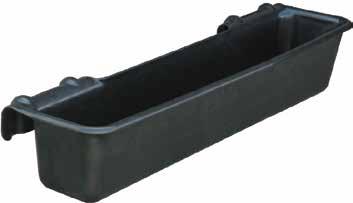


been hospitalized, it has taught me never to take anything for granted. He is my best friend, and we did everything together. To have that ripped from me is something I cannot even explain.

How do you show appreciation for the people you work with every day? We have one employee, and especially this year, she has stepped up to help our farm. To show appreciation, I like to slip treats in the milking bucket for her. I write notes on the white board for her. And if possible, I just do things that will make her chores a little easier.
How do you celebrate Thanksgiving? We go to Adam’s aunt’s house, have dinner and hang out with family. Every year gets a little more interesting because every year there are more kids added. We usually eat so much that we complain during chores about how much we ate.
Tell us about your farm. We milk around 100 cows in a double-5 parlor. The herd is mostly Holstein, but there are more Jerseys added all the time and one Brown Swiss. My husband and I own the farm, and Adam’s dad helps at the age of 72. We have one employee and a parttime milker when her or I can’t milk. We grow hay, corn and soybean to feed the cows but some is cash cropped. Adam and I have three young children. They help feed calves with me almost every night.




















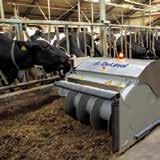



































































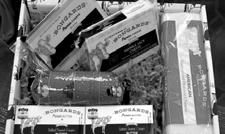

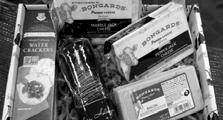
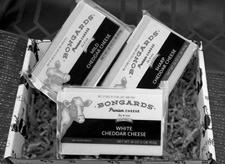




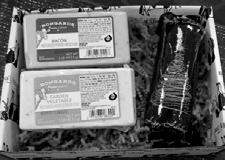

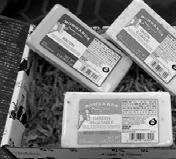

Describe your farm and facilities. The cows are housed in two freestall barns. They are both 4-row barns with deep-bedded sand stalls.


What forages do you harvest? HarvXtra alfalfa, corn and brown midrib corn for silage.

How many acres of crops do you raise? We farm 1,200 acres.


Describe the rations for your livestock. We feed the milk cows roughly 55% forage – 60% corn silage and 40% haylage – whey, corn and protein mix. Dry cows get haylage, corn silage, mineral and straw. Heifers get haylage, corn silage, hay, mineral and soybean meal.
What quality and quantity do you harvest of each crop? We harvest 10,000 tons of corn silage at 65%67% neutral detergent ber digestibility and 30%-35% starch. We harvest 5,000 tons of haylage at 150 relative feed value. And, we harvest 60,000 bushels of high-moisture corn ground to 600 microns.
Describe your harvesting techniques for alfalfa and corn silage. Sullivan Custom Farming and Co-
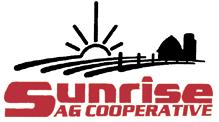
rey Sullivan take care of our cutting, merging and hauling needs. We chop ourselves with a John Deere chop-
per. We chop our own corn silage as Turn to FORAGE
“Starting every fresh cow and heifer with Udder Comfort™ is an important step for quality and that next pound of milk. Udder Comfort is the best product available, and it’s part of what we do for milk production and quality,” says Rick Empet, Empet Farm, Kingsley, Pa., explaining that they spray fresh udders after each milking for 5 days after calving to soften udders.








“We love Udder Comfort,” son Alex adds. Alex was excited to learn he won a free Udder Comfort gallon in the August Comfort Matters Enews drawing after signing up at Empire Farm Days. We caught up with Rick, Dana and Alex busy working on their 6th generation dairy farm. Along with son Aiden and daughter Chelsea, the family is engaged as agvocates with Chelsea serving as a dairy ambassador.





well. We cut alfalfa at a 35to 37-day interval and aim for 60%-63% moisture. For corn silage harvest, we aim for 68% moisture.
What techniques do you use to store, manage and feed your forages? All feed is stored in bunkers; we strive for a high packing den-
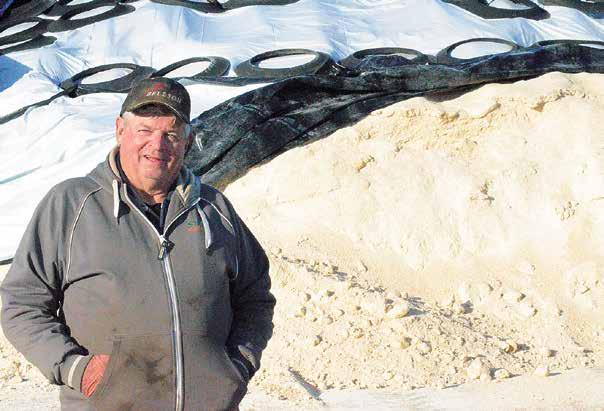
sity to ensure proper fermentation. Bunkers are covered immediately after lling with a vapor barrier and two layers of plastic held down by tire sidewalls. Bunkers are defaced nightly for the next morning’s feeding. We keep the face even and smooth throughout.
Lacta ng cows
the cows’ ra on comes from forages.




Describe a challenge you overcame in reaching your forage quality goals. Several years ago, we invested in a self-propelled chopper; it allows us to be efcient in putting up high quality feed in a timely manner.



How do quality forages play a part in the production goals for your herd? High quality forages allow for the

cows to be productive, reproductively efcient and improve overall cow health.

What are management or harvesting techniques you have changed that have made a notable difference in forage quality? A few years ago, we experimented with HarvXtra alfalfa. It allows for exibility in our cutting
interval, offers high digestibility and increased tonnage. We also transitioned from four cuttings to three cuttings per season. The same goes for BMR corn silage as it has increased ber digestibility. Increasing the digestibility of our own forages has allowed us to decrease the amount of purchased feedstuffs and increases overall production.
JD S680 2013, PRWD, Duals, 2485 hrs., 1604 Sep. hrs., #551147....... $165,000 JD S780 2018, PRWD, Singles, 2489 hrs., 1686 Sep. hrs., #549036 .... $274,900 JD S680 2012, 2WD, Duals, 2631 hrs., 1790 Sep. hrs., #548165 .......$147,500 JD S680 2013, PRWD, Singles , 2635 hrs., 1854 Sep. hrs., #551017 ... $173,900 JD 9760 STS 2004, PRWD, Duals, 3500 hrs., 2251 Sep. hrs., #549273 . $68,000

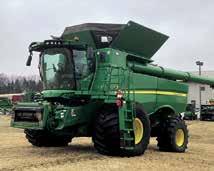
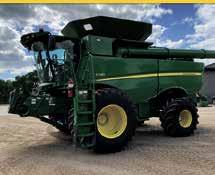
JD 9500 1995, PRWD, Singles, 3543 hrs., 2208 Sep. hrs., #551180 ...... $27,500































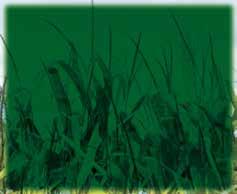

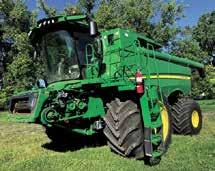
Case IH 2388 1998, 2WD, Singles, 3876 hrs., 2943 Sep. hrs., #549406 $34,900


JD 9660 STS 2006, PRWD, Duals, 3925 hrs., 2453 Sep. hrs., #545355 . $72,000
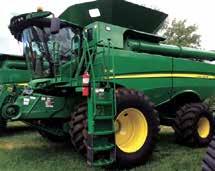
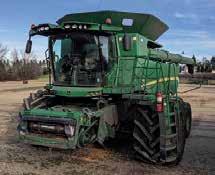
JD 9500 1995, PRWD,
9750 STS 2000, 2WD, Duals, 5299
IOWA
Prairie Land Ag Supply Inc. Rock Valley, IA 712-476-9290


United Dairy Systems, Inc. West Union, IA 563-422-5355
WISCONSIN
Advanced Dairy Spring Valley, WI 715-772-3201







Ederer Dairy Supply Plain, WI 608-546-3713
DeLaval Dairy Service Kaukauna, WI 866-335-2825
Joe’s Refrigeration Inc. Withee, WI 715-229-2321

Mlsna Dairy Supply Inc. Cashton, WI 608-654-5106
Professional Dairy Services Arlington, WI 608-635-0267
Redeker Dairy Equipment Brandon, WI 920-346-5579
The Scharine Group Inc. Whitewater, WI 800 472-2880 Mt Horeb, WI 800-872-3470

MINNESOTA & SOUTH
DAKOTA
Farm Systems Melrose, MN 320-256-3276 Brookings, SD 800-636-5581
Advanced Dairy Mora, MN 320-679-1029 Pierz, MN 320-468-2494 St. Charles, MN 507-932-4288 Wadena, MN 218-632-5416
The smell of coffee, Shania Twain on the radio and the milk pump going are the three most prominent things I keep close to my heart from growing up on a dairy farm.
Being involved in the dairy industry has always been a passion. I knew from a young age I wanted to milk cows like my grandparents and parents. Today, I can proudly say I have my own small herd of registered Holsteins.
Growing up, I enjoyed being in the show ring with my dairy heifers. My parents put me on a halter the day I could walk. From there, it grew into more than just a passion but a lifestyle. I enjoyed showing in 4-H, FFA and the Minnesota Junior Holstein Association.
By Taylor Jerde Staff WriterI come from my family’s fth-generation farm. The farm has had beef cattle, pigs, sheep, horses and of course dairy cattle. I learned what hard work was at a young age from my initial chore of feeding calves.
Even though I had my chores on the farm, I was fortunate to be able to participate in sports and other extracurricular activities. I was in volleyball, dance line, track, National Honor Society and was a senior leader. Some of my proudest accomplishments were breaking a school record in track and advancing from sections to compete at the state dance tournament for multiple years.
I recently graduated from South Dakota State University with a degree in dairy production. Throughout college, I was heavily involved in organizations and clubs. I enjoyed being active in Dairy Club, Block and Bridle, Little International, intramural sports and a small group Bible study.
Being an active person has helped me stay true to myself and be thankful for the rural upbringing I had. Like many, I value my family and enjoy spending time with them when I can. Whether it’s going to a Wild game, traveling to a cattle show, going to a dance competition or going on vacation, I always seem to follow my roots back home. I have always liked living in the country and being around animals.
My family often refers to me as the cow whisperer. I, like many farmers, have had my fair share of favorite cows. Early on, I had a calf named Carli who sparked my passion for showing. Elberta was my next favorite; she was a large Holstein who I referred to as a gentle giant. She knew exactly who I was and only ever listened to me. Stella and Time are my current favorites, as both are previous show heifers who became a little too tame to be normal barn animals.
Perhaps these animals are the reason I love being a part of the dairy industry and telling farmers’ stories. In 2020, I was a Princess Kay of the Milky Way nalist, so I am no stranger to sharing the stories of farmers. I enjoy learning about different farms and the family members who came before them.
Dairy Star is a great way for me to be able to fulll that passion. I am excited to learn about farmers, tell their stories and share the good they are doing. I look forward to continuing to share my passion.
ST. PAUL, Minn. – The University of Minnesota dairy judging team was named victorious at the North American International Livestock Exposition dairy cattle judging contest Nov. 5 in Louisville, Kentucky.

This is the seventh consecutive year that Minnesota has taken rst place at the NAILE contest. The team has taken home the rst-place prize 10 of the past 12 years.

This year’s team includes Ben Styer, of Menomonie, Wisconsin; Kendra Waldenberger, of Spring Grove; Isaac Rott, of Elgin; and Matthew Gunst, of Hartford, Wisconsin.
All four of the team members placed in the top 10 individually.
“I was stoked,” Styer said. “We were hopeful but not expecting it.”
Minnesota received rst overall with a 64-point margin, rst team oral reasons, rst team Ayrshire, second team Guernsey, second team Jersey, third team Brown Swiss and third team Holstein.
The team was coached by Dr. Les Hansen and alumni Eric and Gabriella Houdek.

Styer, who was rst overall and

fth in reasons, majors in animal science. He started showing cattle when he was 5 and has been judging since he was 8.
“Dairy has been a big part of my life from a young age,” Styer said.
After graduation, Styer wants to


get a job in the dairy industry for a few years and then plans to return home to work on his parents’ dairy farm.

Waldenberger, who placed third overall, is a senior studying animal science and agricultural communications and marketing.
“I really enjoy going to all the different farms in Minnesota, Wisconsin and Iowa,” Waldenberger said.
She said in preparation for the



ALLAMAKEE COUNTY
• K & R Feed and Grain
Dorchester
• 563-568-4513
BREMER COUNTY
• Via eld
Sumner • 563-578-3214
DELAWARE COUNTY
• Del-Clay Farm Equipment
Edgewood • 563-928-6445
• Edgewood Feed Mill Edgewood • 563-928-6405
DUBUQUE COUNTY
• Brunkan Equipment
Worthington • 563-855-2434
• CJ Beeps Equipment Farley • 563-744-5010
• Eastern Iowa Dairy Epworth • 563-876-3087
• Helle Farm Equipment Dyersville • 563-875-7154
• New Vienna Ag Automation New Vienna • 563-921-2896
• Roeder Implement
Dubuque • 563-557-1184
• Scherrmann’s Implement Dyersville • 563-875-2426
• Skip Breitbach Feeds Balltown • 563-552-2393
• Ungs Shopping Center (IAS) Luxemburg • 563-853-2455
FAYETTE COUNTY
• Via eld
Elgin • 563-426-5566 Maynard • 563-637-2285
FLOYD COUNTY
• Livestock Systems
Charles City • 641-220-5257
HOWARD COUNTY
• Farmers Win Co-op Cresco West • 563-547-3660
SIOUX COUNTY
• Sioux Dairy Equipment, Inc. Rock Valley • 712-476-5608
WINNESHIEK COUNTY
• Brynsaas Sales & Service Decorah • 563-382-4484
• Franzen Sales & Service Fort Atkinson • 563-534-2724
• Lang’s Dairy Service Decorah • 563-382-8722
BECKER COUNTY
• Adkins Equipment Inc. Detroit Lakes • 218-847-3131
BENTON COUNTY
• Farm-Rite Equipment St. Cloud • 844-262-2281
• First National Bank of MilacaGilman Of ce • 320-387-2233
• Gilman Co-op Creamery Gilman • 320-387-2770
• Midwest Machinery Sauk Rapids • 320-259-6222
BROWN COUNTY
• New Ulm Regional Vet Clinic New Ulm • 507-233-2500
CARVER COUNTY
• Bongards’ Cologne • 952-466-5521
• Lano Equipment of Norwood Norwood/Young America 952-467-2181
• Storms Welding Cologne • 952-466-3343
DAKOTA COUNTY
• Midwest Machinery North eld • 507-645-4886
• Werner Implement Vermillion • 651-437-4435
DOUGLAS COUNTY
• Midwest Machinery Alexandria • 320-763-4220
• Nelson Creamery Nelson • 320-762-0115
• Osakis Creamery Assn. 320-859-2146
• Pro Ag Farmers Co-op Gar eld • 320-834-2271
• Farmers Win Co-op
Rushford • 507-864-2161
• First Southeast Bank Harmony • 507-886-6922
• Hammell Equipment Harmony • 507-886-2255 Rushford • 507-864-2845
• Midwest Machinery Grand Meadow • 507-754-1100
GOODHUE COUNTY
• Ag Partners Farm Store
Goodhue • 651-923-4496
• Midwest Livestock Systems, LLC Zumbrota • 507-732-4673
• Midwest Machinery Cannon Falls • 507-263-4238 Wanamingo • 507-824-2256
• Midwest Machinery Elbow Lake • 218-685-4438
• Caledonia Haulers
Caledonia • 507-725-9000
• ESB Bank
Caledonia • 507-725-3329 Eitzen • 507-495-3321
La Crescent • 507-895-2227
• Farmers Win Co-op Caledonia • 507-725-3306 Houston • 507-896-3147
• Hammell Equipment Eitzen • 507-495-3326
• Midwest Machinery Caledonia • 507-725-7000
• Midwest Machinery Princeton • 763-263-6000
KANDIYOHI COUNTY
• D&D Ag Supply & Construction Pennock • 320-599-4466
• Farm-Rite Equipment Willmar • 877-484-3211
• Midwest Machinery Stewart • 320-562-2630
MCLEOD COUNTY
• Leedstone Glencoe • 877-864-5575
• Midwest Machinery Glencoe • 320-864-5571
• Mueller Sales & Service Dairy Equipment Glencoe • 888-205-0974
• Farm-Rite Equipment
Dassel • 888-679-4857
• Schlauderaff Implement Co. Litch eld • 320-693-7277
MILLE LACS COUNTY
• First National Bank of Milaca
Milaca • 320-983-3101
• Foreston Farmer’s Co-op Creamery Foreston • 320-294-5711
MORRISON COUNTY
• Central MN Credit Union Little Falls • 888-330-8482
• Lash’s Auto Pierz • 320-232-0537
• Litke’s Veterinary Service Pierz • 320-468-6666
• Midwest Machinery Little Falls • 320-632-5469
• Modern Farm Equipment Pierz • 320-468-2161
• Pierz Co-op Pierz • 320-468-6655
• Sunrise Ag Cooperative Buckman • 320-468-6433 Lastrup • 320-468-2543 Little Rock • 320-584-5147
OLMSTED COUNTY
• Ag Partners Stewartville • 507-533-4222 Lewiston • 507-523-2188
• Hammell Equipment Chat eld • 507-867-4910
OTTER TAIL COUNTY
• Bongards’ Perham • 218-346-4680
• Farmers Elevator of Fergus Falls & Henning 218-736-3301
• PCCA-Country Store Perham • 218-346-7075
• Perham Stockyards Perham • 218-346-3415
• Pro Ag Farmers Co-op in Henning 218-583-2947
• Pro Ag Farmers Co-op in Urbank 218-267-2401
PIPESTONE COUNTY
• Gorter’s Clay & Dairy Equipment Pipestone • 507-825-3271
POPE COUNTY
• Midwest Machinery Glenwood • 320-634-5151
RICE COUNTY
• Ag Partners - Agronomy Le Center • 507-357-6868
STEARNS COUNTY
• A&C Farm Service
Paynesville • 320-243-3736
• Albany Chrysler Dodge Jeep Ram Albany • 320-845-2801
• Arnold’s of Kimball Kimball • 320-398-3800
• Arnold’s of St. Martin St. Martin • 320-548-3285
• Arnzen Construction/St. Rosa Lumber Freeport, In St. Rosa 320-836-2284 or 1-888-276-1751
• Magni Financial Albany • 888-330-8482 Avon • 888-330-8482 Belgrade • 888-330-8482 Cold Spring • 888-330-8482 Freeport • 888-330-8482 Melrose • 888-330-8482 Paynesville • 888-330-8482 Sauk Centre • 888-330-8482
• Centre Dairy Equipment & Supply Inc. Sauk Centre • 320-352-5762 or 1-800-342-2697
• Dairyland Supply Sauk Centre 320-352-3987 or 1-800-338-6455
• Ecker Feed Service, LLC New Munich • 320-837-5800
• Elrosa Grain & Feed Elrosa • 320-697-5515
• Elrosa Lumber Elrosa • 320-697-5591
• Farm Systems Melrose 1-800-636-5581 • 1-800-247-0012
• Feed Co.
Paynesville • 320-243-3938
• Freeport State Bank Freeport • 1-800-252-9856 320-836-2126
Greenwald • 320-987-2265 New Munich • 320-837-5297 Melrose • 320-256-7208
• Hartung Sales & Service, Inc. Freeport • 320-836-2697
• Lake Henry Implement Lake Henry • 320-243-7411
• Leedstone Melrose • 800-996-3303
• Melrose Implement Inc. Melrose • 320-256-4253
• Midwest Machinery Paynesville • 320-243-7474 Sauk Centre • 320-352-6511
• Modern Farm Equipment Sauk Centre • 320-352-6543
• Nutrien Ag Solutions 320-352-6564
• Northland Farm Systems Owatonna • 507-451-3131
SWIFT
• Midwest Machinery Benson • 320-843-2610 Madison • 320-598-7575 Morris • 320-589-2011
TODD
• Magni Financial Grey Eagle • 888-330-8482 Long Prairie • 888-330-8482
• Farm-Rite Long Prairie • 866-514-0982
• Olson’s Custom Farm Service Staples • 218-894-2474
• Pro-Ag Farmers Co-op in Browerville Browerville • 320-594-2711
• Pro-Ag Farmers Co-op in Clarissa Clarissa • 218-756-2112
• Pro-Ag Farmers Co-op in Eagle Bend Eagle Bend • 218-738-2552
WABASHA
• Ag Partners Farm Store Plainview • 507-534-2531
• Beck Implement Elgin • 507-876-2122
• Leedstone Plainview • 800-548-2540
• Midwest Machinery Plainview • 507-534-3116
• Wingert Sales & Service Plainview • 507-534-2285
WADENA COUNTY
• Dairyland Equipment of Menahga Menahga • 218-564-4958
• Midwest Machinery Wadena • 218-631-2311
• Olson’s Custom Farm Service Verndale • 218-445-5500 Sebeka • 218-837-5749
WINONA COUNTY
• Elba Co-op Creamery Elba • 507-796-6571
• Lang’s Dairy Equipment Lewiston • 507-452-5532
• Lewiston Rentals and Repairs Lewiston • 507-523-3564
• Midwest Machinery St. Charles • 507-932-4030
WRIGHT COUNTY
• Hobert Sales Inc. Cokato • 320-286-6284, 1-800-820-6455
• Midwest Machinery Howard Lake • 320-543-2170
BROOKINGS COUNTY
• W.W. Tire Brookings • 605-696-7400
CODINGTON COUNTY
• Glacial Lakes Livestock Watertown • 605-886-5052
MINNEHAHA COUNTY
• Central Valley Dairy Supply Garretson • 605-467-0812
• Midwest Livestock Systems Renner • 605-274-3656
ROBERTS COUNTY
• Valley Dairy Supply Corona • 605-432-5224
berger said.
Waldenberger did not grow up on a dairy farm but instead got involved in showing cows with a dairy farm through the 4-H leasing program. When she became employed at the

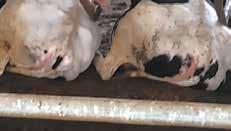
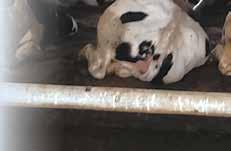





neighboring dairy, she found her passion. After graduation, Waldenberger intends to work with dairy cattle genetics.
Rott, who was eighth overall, is also an animal science major.
“My favorite part of being on the judging team is hanging out with all my teammates on judging trips,” Rott said. “While we are stressed out, we still have fun.”
The rest of the team agreed.
Rott grew up on a dairy farm. His family has since sold the cows and now raises heifers for another dairy farm. After graduation, Rott hopes to get a job in the dairy industry for a few years then return to the farm.
Gunst, who placed ninth overall, is a senior majoring in animal science and agricultural communications and marketing.

“To say I am sincerely blessed to have been a member of the teams representing the University of Minnesota would be an understatement, and I can wholeheartedly say I have developed both personally and professionally from these experiences,” Gunst said.
For Gunst, the NAILE contest was bittersweet; this was his last judging contest as a senior member of the dairy judging team.
“I wanted to go out with a bang and take the win for the U of M,” Gunst said. “Our team had practiced countless hours, and we were all lled with anticipation for the results.”
Gunst grew up as the sixth generation on his family farm. His family sold the cows in 2011, and now, Gunst and his sister run a custom boarding business. After graduation,
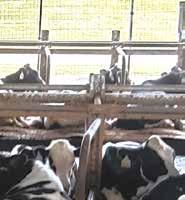
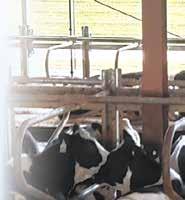

Gunst plans to work in marketing for an agricultural company and continue to breed and show top quality dairy cattle.
Hansen has been leading the dairy judging team at the school since 1981. Growing up on a Minnesota dairy farm himself, Hansen has been fascinated by the genetics in dairy cattle. Hansen said he appreciates how hard the team has been working.
“Success requires commitment; one feeds the other,” he said.
Hansen said this year’s team has been thrilled to get back to in-person activities. Hansen teaches his students that the goal is not to win trophies but rather to learn, bond with teammates and develop decision-making.
“It feels fantastic,” Hansen said. “I have a tremendous pride in each and every one of them.”
The University of Minnesota dairy judging team also placed rst at the All-American Dairy Show in September in Harrisburg, Pennsylvania, second overall at the Vernon County Dairy Judging Contest in September in Viroqua, Wisconsin, and sixth overall at World Dairy Expo in October in Madison, Wisconsin.
“It feels fantastic. I have a tremendous pride in each and every one of them.”
DR. LES HANSEN, UMN DAIRY COACH
The following individuals received their American FFA Degree and grew up on area dairy farms. More recipients were highlighted in the previous issue.
The American FFA Degree is the highest degree an FFA member can achieve. To achieve the American Degree, FFA members must show dedication to their local and state association. Members must excel in their supervised agricultural experience and show leadership qualities through community service and at their local chapter. Less than 1% of FFA members achieve their American Degree each year.
Mikayla Thorson Waverly, Minnesota South Dakota State University AgricultureWhy did you want to obtain your American FFA Degree? The American Degree is the highest degree an FFA member can obtain. Receiving the American Degree has been a goal of mine since before my FFA career began. I watched members of my chapter work toward it year after year. My FFA advisors and family have always encouraged me to work toward receiving my American Degree. FFA has been a critical part of my growth and development as both a leader, educator and an agriculturalist. Walking across stage and shaking the national FFA president’s hand to receive the award was the capstone achievement on my career as an FFA member.
What did you have to do to obtain your American FFA Degree? There is a long list of requirements that must be achieved prior to receiving the degree. Some of mine include having a satisfactory supervised agricultural experience and being involved in my community through service hours. I maintained a satisfactory scholastic record. I received the State Degree, Chapter Degree and Greenhand Degree. I completed 540 hours of agricultural education courses through my high school agriculture department and earned at least $10,000 and productively invested $7,500. Additionally, I was required to ll out an application which demonstrated that I was eligible for the award.
What did you participate in for FFA? FFA was a large part of my high school
Brea Kieffer Utica, Minnesota University
of Wisconsin-River Falls
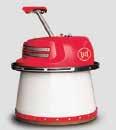
Biology and dairy science
Why did you want to obtain your American FFA Degree? To nish out my FFA career on a great note and achieve the highest degree I could to showcase all the work I put into FFA.

What did you have to do to obtain your American FFA Degree? I already had most of my community service hours through 4-H and had done a lot of work for my supervised agricultural experience that helped me obtain my American Degree.
What did you participate in for FFA? I was on the ofcer team for the St. Charles FFA Chapter, serving as presi-
career. I was blessed with the opportunity to be a part of the livestock judging team and horse judging and dairy evaluation career development events. I participated in the conduct of chapter meetings, best informed greenhand, job interview and farm bureau discussion meet leadership development events. I also served alongside other chapter members as the vice president of our chapter ofcer team, and I had the privilege to work with Region 4 members as their reporter. I also enjoyed being a part of many community events including the FFA alumni tractor pull, the ag parade, corn drive and our summer agriculture program.
What are your future plans? I am a student at South Dakota State University studying agriculture science with minors in animal science and ranch management. Completing my career as a student is at the forefront of my mind, but after college, I would like to pursue a career in production agriculture working alongside the people who provide the food, ber and fuel for our world.
Tell us about your farm. I grew up on my family’s dairy farm, Diers Corporation (Rol-lyn Dairy) where we milk Holstein and crossbred dairy cows and grow corn, alfalfa and soybeans. We also have beef cows, chickens and a few pigs. My mom and dad are full-time dairy farmers and work with other individuals to ensure the success of our business. Our farm originated in 1874. Dairy farming has its blessings and challenges, but I can speak for my family when I say that it is a passion for educating consumers and caring for livestock and crops that keeps us going each day.
dent, vice president, secretary and chairperson. I also helped with various community service activities and school functions as well as showing in local and state fair FFA dairy shows.




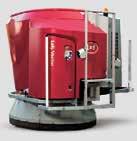



What are your future plans? Once I graduate from the University of Wisconsin-River Falls, the rest is up in the air as of now. I may possibly go on to graduate school or work in the dairy industry with genetics or go back to my family farm.
Tell us about your farm. My family farm, Kieand Holsteins, is a fourthgeneration farm located outside Utica, Minnesota. We milk 350 Holsteins in ve Lely robotic milking units. I enjoy working with the lactation cows as well as managing our growing show cattle herd.
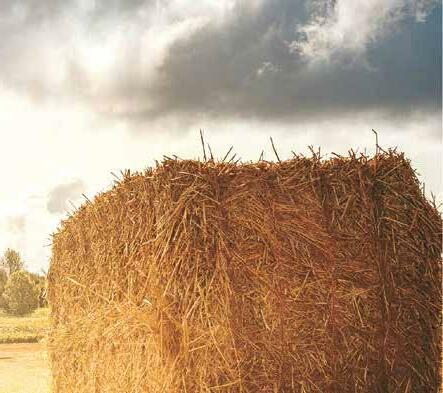


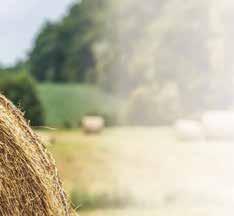



Green County 62 cows
Family: My husband, Todd, and I have been married for 34 years. We have one son, Jake, who is 29. He is a horticultural assistant and native plant specialist at RES Great Lakes/Taylor Creek Restoration Nurseries in Brodhead, Wisconsin. We also have a daughter, Paige, who is 26. She is a registered behavior technician at Arizona Autism United in Phoenix, Arizona.
Tell us about your farm. We milk 68 registered Holsteins in a New York tiestall barn. The cows are fed a total mixed ration. They’re on pasture in the summer and fall as long as weather permits. They are fed at an H-bunk in the pasture in the summer and fall. In the winter, they’re out for exercise for a couple of hours with feed available at a J-bunk. We have only 27 acres of tillable ground, so we make all our corn silage and purchase all the hay, shell corn and commodities. Our focus has always been on working with the cows, building strong pedigrees with great longevity. Our herd BAA is currently 111.4%, putting us in the top 200 in the country for BAA for the last 20-some years. Currently, we are ninth in the country for our herd size. Merchandising animals from the families we’ve been building has always been a key to our success. We consign animals to many sales and have sold animals across the country as well as exported around the world. When our kids were younger, we were very active in the show ring as well showing at 4-H shows, district and state Holstein shows, and World Dairy Expo. Now that they are grown and off the farm, I wonder how in the world we had time to do it all. Our workforce consists of mostly Todd and myself. Jake helps with chores on weekends and evenings when he’s not traveling for work. Paige likes to get home to visit as often as she can and enjoys helping as much as possible. My father-in-law, EJ, comes every morning and helps mix the TMR.

What is a typical day like for you on the dairy? The rst thing I do is help get milking underway. We always have a few cows to switch in and out, so I help until we’re past that point. Then, I feed the weaned heifers and baby calves. My weaned heifers (3 months to 10 months) get fed 4 pounds/head of 16% grower twice per day. The baby calves get a half-gallon
milk replacer and 4 pounds of 18% starter twice per day. I usually have between 10 and 20 babies and 30 or so heifers up to breeding age. After 2 months of age, all the heifers have free choice grass/alfalfa hay available. Once I’m nished with calf chores, I help with the rest of the barn chores (cleaning, bedding, etc.). After I’m done in the barn, I’m able to take care of the household tasks – advertising, grocery shopping, lawn mowing, bookkeeping, calf registration, meal preparation, laundry, etc. House cleaning is last on my list of things to do.
What decision have you made in the last year that has beneted your farm? Thirty years ago, I gave up my job as an art director at an advertising agency in Madison to be a stay-at-home mom. I started my freelance graphic design business, Spring Creek Design. I built my clientele into almost exclusively dairy and ag-related clients. It was perfect to have this business where I could be at home with my kids and still be available for farm work. Within the last couple years, I’ve really pared down my graphic design, narrowing my clients down to just one, who I especially enjoy working with. This decision allowed me to transition into a more fulltime role with the day-to-day work. As our kids grew and started their own careers off the farm, it was really important to me that I could work more on the farm. As all farmers know, every day is a ton of work, and for my husband to be doing most of it alone was tough. I feel good that I can be of more help.




Tell us about your most memorable experience working on the farm. I would say most of the really memorable experiences revolve around classication. Working all night washing and clipping to get ready for the classier, and then taking

the few hours, absolutely dead on my feet while he or she scored the herd, is a feeling I’m sure I’ll never forget.
What have you enjoyed most about dairy farming or your tie to the dairy industry? There are a couple of things I’ve truly enjoyed. First, all the showing we’ve done together as a family. When our kids were younger and involved with 4-H and Junior Holsteins, the show season was very busy. They had a lot of great success – each one of them being able to show a Junior All-American nominee or two. Everyone had their role, whether it was being home to get things done or taking care of the string at each show. The second favorite thing has been meeting many people from all over the place. Over the years, we’ve been honored to host many tour groups to our farm. I’ve enjoyed meeting other breeders from all across the country as well as many international guests. We hosted one of the ofcial WDE tours a few years ago when bus loads still came right to the farm. That year was especially fun; we met groups from Japan, Brazil, Argentina and Canada.

What is your biggest accomplishment in your dairy career? I’m most proud of how I have learned this life. I didn’t grow up anywhere near the dairy industry. The rst time I was ever on any farm was when I visited my husband’s family farm when we rst started dating. It was a totally foreign environment. So, I’m pretty amazed at how much I learned about this life, the partner I became and how together we built our herd into what it is today. I’m also proud of my overall involvement in the industry. I served 12 years as the Green County Junior Holstein advisor. I was also the 4-H dairy leader the whole time my kids showed in 4-H. Putting together educational dairy displays and helping kids
with their showing was rewarding. This year, I was chosen as the Green County Senior Agri-Business Woman of the Year, which was a huge honor.
What are things you do to promote your farm or the dairy industry? We promote our herd through advertising in the Cattle Connection. We’ve been advertising in that publication since its inception. It’s a great way to connect with breeders from around the globe. We’ve also been utilizing social media as it has grown into such a huge industry. I try and post current photos of individuals and pedigree information as well as any news that is affecting our farm. Having not grown up on a farm, I have many friends and family who are completely unfamiliar with the dairy industry and animal ag in general. I make myself available to them to answer questions, dispel misinformation and make them more aware of how our industry affects their daily lives.

What advice would you give another woman in the dairy industry? Women can do anything in this industry. In the 35 years we’ve been farming together, there are women in so many roles that were traditionally for men. Farm managers, veterinarians, feed specialists and A.I. technicians; there’s not much a woman cannot do in this industry.
When you get a spare moment, what do you do? Having gone to school at the University of Wisconsin-Madison, I enjoy following all the Badger sports. Anyone who knows me knows how much I love my herd of barn cats. If there’s a batch of kittens around, and I have a spare minute, you can usually nd me messing around with them. I’ve also been a ute player since the fth grade. I enjoy playing at my church or in the local community band.
www.extension.umn.edu/dairy
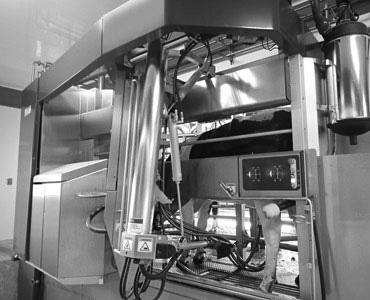

Getting into the dairy industry is difcult, particularly considering the signicant overhead required. Expanding an existing dairy can have similar challenges. There is no getting around it; buildings are expensive, especially brand-new buildings with all the bells and whistles of free stalls, sand bedding and ventilation. We often think of dairy cows as fragile, mainly because we compare them to beef cows, but they are still cows and plenty hardy enough to thrive even in a Minnesota winter.
Housing dairy cattle without a roof is a viable option for older heifers and mature cows. This can certainly work as a permanent option for housing cattle but also can help during transitional periods during expansions or startups. Severe weather conditions are certainly a concern, but with the right setup, we can keep cows healthy without a building.
To make outdoor winter housing effective, there are a few key components. A windbreak, bedding space, bunk space and water space are the most important factors.
Especially in the winter, a windbreak is one of the most important things you can provide your cattle to help them stay comfortable. Windbreaks can be naturally occurring (trees) or man-made (buildings, rows of stacked bales and other structures). The windbreak should ideally
cover the bedded pack, feeding area and watering area. Cattle will often seek out windbreaks if one isn’t provided and prioritize getting out of the wind ahead of food and water in severe winter weather.
A bedded pack provides a comfortable place for cattle to relax and ruminate. A bedded pack also keeps cattle warm and dry and should provide 100-squarefeet per cow. After a windbreak, keeping cattle dry is the next most crucial factor for successfully getting through severe winter weather. If you don’t have a bedded pack, it is benecial to provide deep bedding behind your windbreak when you know severe weather is approaching.
Adequate bunk space limits competition for resources, especially when there are mixed age groups in an area. Having sufcient bunk space will also produce a group of cattle that have a similar body condition. Having uniform body condition within a group makes nutrition decisions more applicable and makes maintaining body condition goals more achievable. Correct body condition management can result in improved performance in all aspects of a cattle operation. Provide two linear feet of bunk space per cow for the best results.



Water is often the forgotten nutrient, despite it being the most important. Proper hydration is essential for proper immune function and overall health, and water drives dry matter intake, meaning it is also the most crucial nutrient for

performance. The recommended water space is 1-2 linear inches of water space per cow. Without adequate water access, cattle will lose performance and body condition. If water is unavailable for long enough, cattle will attempt to eat snow, but they cannot consume enough snow for their water needs.
One of the most critical factors for cattle is acclimation to the weather. Cattle expected to live outside during the winter should remain outside to adjust to the changing conditions as winter approaches. This will allow the cattle to grow a thick hair coat in preparation for the cold. The hair coat needs to stay clean and dry to provide the best insulation protection for the cow.
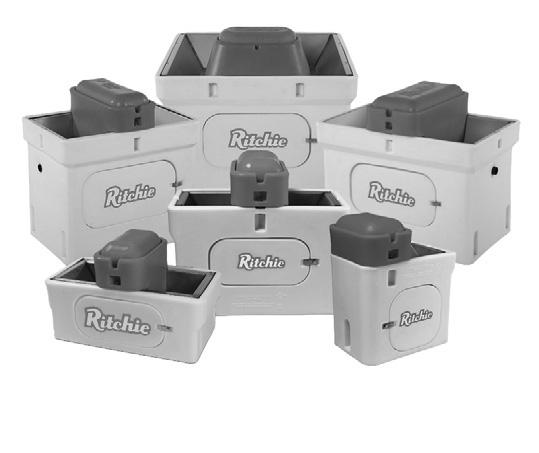
The correct body condition for cattle will help them overwinter and help dry cows come into calving healthy. Stable body condition through the winter months will ensure cattle are best prepared to ride out severe winter weather when it happens. Uniform body condition allows targeted nutrition for the group, which is important when needing to in-


Dana Adams, adam1744@umn.edu 320-204-2968
Joe Armstrong armst225@umn.edu 612.624.3610
Luciano Caixeta lcaixeta@umn.edu 612-625-3130
Gerard Cramer gcramer@umn.edu 612-625-8184
Marcia Endres miendres@umn.edu 612-624-5391
Joleen Hadrich jhadrich@umn.edu 612-626-5620
Les Hansen hanse009@umn.edu 612-624-2277
crease the amount of feed during colder temperatures.


In extreme cold, cattle require more calories to maintain their body condition and stay warm. When the temperature approaches zero degrees Fahrenheit, you can expect to feed about 30% more than you would at temperatures above 32 degrees. Using your feed to congregate your cattle where you want them to be ahead of incoming severe weather is a great strategy. When a storm is approaching, place feed behind your windbreak to encourage your cattle to stay there.
Creek bottoms, swales and other similar landscape features can be tempting places to use as windbreaks. The problem with using these locations is that they are the prime locations for drifting snow. High winds combined with snow can create deep drifts that cause access issues for feeding cattle, water access issues and buried cattle. It is better to avoid these areas if possible and set cattle up for success in a place where heavy drifting is less likely.
Brad Heins hein0106@umn.edu 320-589-1711
Nathan Hulinsky huli0013@umn.edu 320-203-6104
Kevin Janni kjanni@umn.edu 612-625-3108
Karen Johnson ande9495@umn.edu 320-484-4334
Emily Krekelberg krek0033@umn.edu 507-280-2863
Claire LaCanne lacanne@umn.edu 507-332-6109
Brenda Miller nels4220@umn.edu 320-732-4435

Erin Royster royster@umn.edu
Isaac Salfer ijsalfer@umn.edu 320-296-1357
Jim Salfer salfe001@umn.edu 320-203-6093
Mike Schutz mschutz@umn.edu 612-624-1205
Emma Severns sever575@umn.edu 507-934-7828
Melissa Wison mlw@umn.edu 612-625-4276
Greek philosopher named Heraclitus is quoted as saying, “Change is the only constant in life.”
After working at the University of Minnesota for more than 40 years, I am wrapping up my responsibilities and cleaning out my ofce. While cleaning, I found books from ve of the dairy housing conferences organized by the American Society of Agricultural and Biological Engineers held between 1973 and 2003. The books got me thinking about changes and innovations that occurred in the dairy industry over the past 40 years.
In 1973, Paul Shea, an agricultural engineer with Minnesota Power and Light, reported that over half the new barns built in Minnesota in 1972 were tie stall. Tiestall barns were reported at the 1983 and 1994 conferences but not later conferences.
Minnesota was a hot bed of compost barn development. Minnesota’s rst compost barn was put into operation in 2001. By 2006, there were more than 30 compost barns in Minnesota. The University of Minnesota Extension dairy team hosted an international compost dairy barn conference in June 2007. Numerous research studies were conducted to better understand cow performance and pack management.
The rst cross-ventilated barn was built in North Dakota in 2005. Between September 2015 and August 2016, air temperatures and relative humidity levels were measured in a unique cross-ventilated barn in Minnesota. The unique barn was naturally ventilated in cold and mild weather and cross-ventilated in warm and hot weather. Minnesota dairy producers now use a range of barn types and innovative ventilation systems.
Total Minnesota milk production has increased from 9.6 billion pounds per year in 1970 to 10.5 billion pounds per year in 2021, even though cow numbers have declined from 949,000 to 461,000 cows over the same period (Figure 1). To accomplish that feat, milk production increased from 10,154 to 22,881 pounds per cow per year over the 51-year period.
Paul Shea also wrote about the lifting dairy farmers did for milking, feeding and manure removal in the early 1970s. I did some feed and manure lifting when I was growing up. Today, operators in milking parlors lift and attach milking equipment but do not lift the milk harvested. Milking robots can prepare cows and harvest milk without human lifting.
Dairy farms today have equipment that reduces lifting for mixing and delivering total mixed rations and handling manure. Robotic feeding systems eliminate much of the back-breaking lifting dairy farmers used to do. New and smaller sensors, cameras and more powerful electronics continue to provide dairy managers with more automation and information. Managers use the information to make operating and management decisions. Four Precision Dairy Conferences have been held in Minnesota since 2013.
Dairy producers have more ventilating options including natural ventilation, tunnel ventilation, cross ventilation and push-pull ventilation. Push-pull ventilated dairy barns have fans blowing air both into and out of barns to ventilate them. Positive pressure tube systems are an option too.
The type and size of equipment
available today provides managers with more tools to manage heat stress better. Low-pressure feedline sprinklers, highpressure misting systems, and mixing fans in barns and holding areas are tools developed over the past 40 years that help farmers manage cow heat. Numerous studies developed design and management guidelines.

Bigger, more efcient fans
Barns using tunnel, cross and pushpull ventilation rely on lots of fans. Many natural-ventilated barns have mixing fans. Most producers use larger energy efcient fans that were not available in the ‘70s and ‘80s. In the ‘80s, 36-inch diameter axial fans were some of the largest available. Now 60-inch diameter fans are available.
Lighting used in dairy barns and milking centers has changed. At the 1994 Dairy Housing Conference, R.R. Peters, an animal scientist at the University of Maryland, reviewed research on light
levels and photoperiod management for dairy cows from the mid and late 1970s. Lighting to provide 16 to 18 hours of light per day at between 10 to 30 foot-candles was reported to be paid for in two fall and winter seasons.
In the ‘90s, incandescent lights were replaced with uorescent, metal halide or high-pressure sodium xtures depending on ceiling height. Twenty foot-candles was the design minimum. Today, LED with their long life, great color rendition and energy efciency are commonly used. The LED xtures that handle damp and corrosive environments serve the lighting needs in dairy barns and milking centers well.
Dairying will continue to change and be hard work, even with the new barns, equipment and robots. More options and choices make designing and managing a dairy operation more complicated. Animal care and well-being are priorities as well as protability in a changing world. Keep up the good work. Best wishes in your future endeavors.
Why did you want to obtain your American FFA Degree? I wanted to get this degree to show other kids in my FFA chapter the possibilities and the options they can do within FFA. When I was a region ofcer, I wanted to show kids who don’t come from a farm that there are a lot of options for them in FFA. I got my Greenhand Degree, Chapter Degree and State Degree, and I thought that would be a good nal goal to have. I wanted to start farming right away so running for state ofcer wouldn’t be a good t.
What did you have to do to obtain your American FFA Degree? You have to have a supervised agricultural experience to get your American Degree, and I ended up doing two SAEs. For my diversied livestock production SAE, I milked cows for my parents. One summer, I raised pigs, and the next summer, I raised goats. I had to have paid and unpaid hours to achieve the American Degree, and between 4-H and FFA, I did a lot of volunteering. I worked for neighboring farmers as well. My other SAE was nursey/landscape man-
agement. I worked for a local greenhouse and did some landscaping on the side for a bunch of lake home owners in the area.
What did you participate in for FFA? I was a chapter and region ofcer. I did dairy handling, dairy judging, meats judging, farm business management and employment skills. I wanted to do a lot of events so I can have that experience and tell other kids about all the opportunities in FFA, even if they don’t come from a farm.
What are your future plans? To keep farming. I own animals and rent 220 acres. My parents and siblings help me when they are not working their in-town jobs. I milk 25 cows and have youngstock as well at a neighbor’s place.










Tell us about your farm. My parents milked 44 cows and farmed 120 acres, but they sold the cows in the spring of 2020. That fall, I started working for a neighboring farmer. The spring of 2021, I rented half of my dad’s land. Then, this year, I rented all of my dad’s land and picked up some more acres as well.

Waterville,

Why did you want to obtain your American FFA Degree? It was the highest honor an FFA member can achieve on their own.
What did you have to do to obtain your American FFA Degree? Lots of paper work. Members have to get 360 hours of classroom time, 90 hours of volunteer time and do a supervised agricultural experience. My SAE was in dairy placement, and I worked on my parent’s dairy farm.


What did you participate in for FFA? I did the dairy evaluation career development event. We

won the state contest and went to nationals. Then, I did the farm business management CDE. I was chapter secretary and then vice president. I helped with the thank-a-farmer meal, trick or treating for the food shelf and helped with the baby animal day events our chapter hosts. The connections I have made while in FFA have helped make me who I am today. I have met many lifelong friends because of FFA.
What are your future plans? After graduating college, I plan to go back to the family farm and farm.
Tell us about your farm. We milk 750 cows and farm 2,000 acres of corn, soybean, oat, wheat and alfalfa. We raise our replacement heifers and raise our steers to 400 pounds. We also raise turkeys for Jennie-O.

What did you have to do to obtain your American FFA degree? FFA members need to have a successful supervised agricultural experience project.
Why did you want to obtain your American FFA Degree? I wanted to get my American Degree because it is one of the last awards you receive as a FFA member. Being less than 1% of FFA members receive this award, it was pretty exciting that I was chosen to receive the American Degree.
What did you participate in for FFA? I participated in employment skills and dairy cattle evaluation.
What are your future plans? As of right now, I am undecided.
Tell us about your farm. I grew up on a hobby farm, and then in 2015, my sister and I started a dairy farm, JENARIC Dairy.
How did you get into farming? I grew up on our family farm milking, driving tractor and everything else involved. Being the oldest meant I had a ton of responsibilities with the farm.
What are your thoughts and concerns about the dairy industry for the next year? I think ination and policies are some of the big concerns. The number of farms exiting the industry makes my head spin.







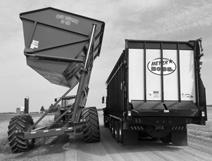


What is a recent change you made on your farm and the reason for it? We no longer breed animals to calve in December, January or February. With very little to no help, it is hard for me to get chores done and try to give calves the adequate attention they need. Plus, it is just hard calving cows in and raising calves in those months.


Tell us about a skill you possess that makes dairy farming easier for you. I am trained to do my own articial insemination. It is nice to not have to leave animals in, remember to call the breeder or have to use the bulls they sell. It is cheaper and more convenient to do it myself.

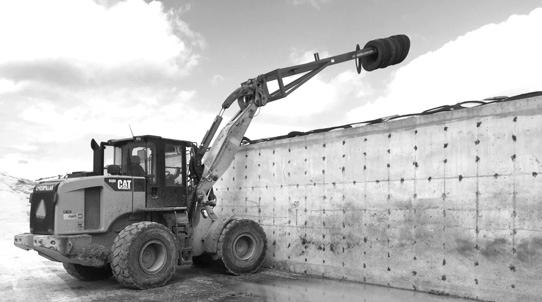
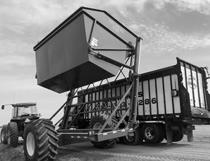
What is the best decision you have made on your farm? To become more diversied.
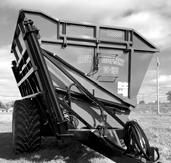
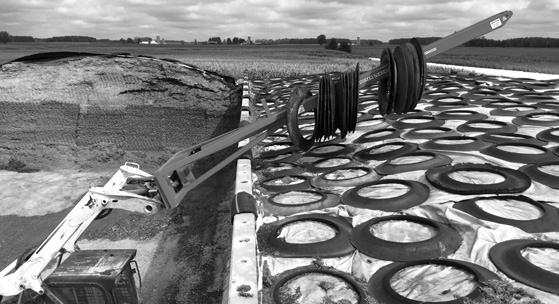

What are three things on the farm that you cannot live without? I couldn’t get by without the skid loader. We have designed the farm to make everything available to be done with the skid loader. All-terrain vehicles are also invaluable. We use them to pick rocks, haul calves, among a multitude of other things. My kids have also gotten to the point of being a ton of help and can use the ATV to do jobs for me.
What strategies do you use to withstand the volatile milk prices? We took out the highest insurance policy that was offered to help offset the volatility of the milk prices.
How do you maintain family relationships while also working together? I farm with my parents while my husband works in town. It works for us. We don't ever walk away mad or do things to upset one another.
What do you enjoy most about dairy farming? I enjoy being my own boss and having my kids with me all summer.
What advice would you give other dairy farmers? It is the hardest job you will ever have but also the most rewarding.

What are your plans for your dairy in the next year and ve years? We are planning to keep doing the same thing we are now. I have looked into doing some more no-till but haven't crossed that bridge yet.
How do you or your family like to spend time when you are not doing chores? We love going swimming, and going to my kids’ sporting events takes up all my free time year-round.



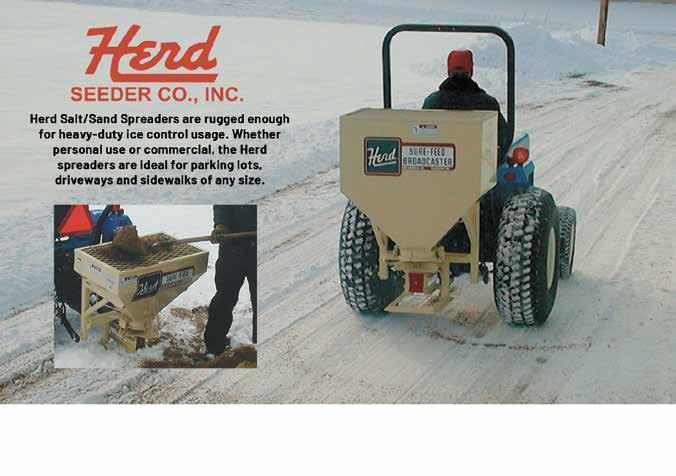








The 2022 corn silage harvest is in the rearview mirror. The dry fall provided an ideal harvest window for many growers and allowed them to achieve dry matter targets. What are our expectations of animal performance with this crop? We’ve heard reports of new corn silage feeding quite well in some areas and not so well in others. An array of factors might help explain this variation, including weather, plant genetic variation and agronomic practices such as planting dates, population, fertilization and fungicide application.
Last year’s corn silage harvest can provide perspective on some of these factors. Just over a year ago, nutritionists, dairy producers and cows were trying to gure out how newly harvested corn silage was going to feed – an annual phenomenon with incredibly important implications.
A wide range of storage options and logistics dictate when a farm will need to transition from fully fermented corn silage into silage from the new harvest season. This timeline ranges from feeding the day of harvest to several months of carryover and fermentation time. Allowing adequate storage time for wet corn is the greatest supporter of starch availability. Prolamin-zein proteins encapsulate corn starch and act as a barrier to digestion. Over time, protease enzymes (produced by proteolytic bacteria) break down this protein matrix, making starch more available. The wetter the corn source, the quicker this process occurs and the sooner the feed will reach its full starch digestibility potential.
Dairyland Laboratories Inc. recently summarized nearly 12,000 corn silage samples for the past three years across Minnesota. Results show a wide range in ber and starch content as well as ber and starch digestibility. In general, the 2021 crop was lower in starch percentage and higher in ber digestibility. Starch digestibility seemed to take longer to reach its full potential and, in most cases, never did reach levels achieved in the previous few years.
Historically, kernel maturity of approximately half milk line would correlate to about 65% wholeplant moisture. This has not been the case for many farms the past couple years. Dr. John Goeser with Rock River Laboratory Inc. has dened this change as a “moisture and kernel maturity disconnect.” Goeser said the growing season and conditions have a major impact on moisture, maturity and overall quality. He also pointed out that improved agronomic practices and healthier plants are inuential factors. Examples such as better stay-green, drought tolerance or improved fungicide application strategies are likely resulting in healthier plants and greener tissue as the kernels mature and progress toward black layer.
For many in the Midwest, the average rainfall in 2021 and 2022 were similar and decient throughout much of the growing season, but we certainly had exceptions to this trend in some areas. This is what makes it difcult to paint with a broad brush that corn silage across an entire region will perform equally.
Early indications from lab analysis show an improvement in the rate of starch digestibility in 2022 corn silage over the 2021 crop across comparable time periods. This can be seen in lab analysis with both seven-hour starch digestibility and starch Kd rate, which is a measurement of the rate of starch digestibility. Time will tell how extensively this pattern continues.
The one thing we know for certain about future corn silage harvests is they will be different from the past. It is likely we will continue to see a trend for kernel maturity to be well past half milk line at harvest with some of the agronomic practices designed to promote a healthier plant. This will require closer monitoring of whole-plant moisture at harvest along with greater emphasis on kernel processing.
Barry Visser is a nutritionist for Vita Plus.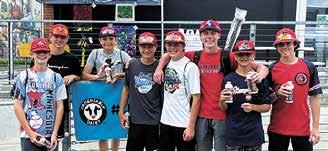
Midwest Dairy relies heavily on current consumer research and insights to help us develop annual strategies and action plans that positively impact sales and trust across our 10-state region. Research shows that when consumer sentiment toward the dairy industry as a whole is positive, consumers are more likely to make dairy purchasing decisions when at the dairy case. For this reason, Midwest Dairy works with partners with a large consumer audience, including the targeted audiences of Generation Z and their parents, to build trust in and around dairy.













 By Lisa Rutherford Midwest Dairy manager of wellness and communications
By Lisa Rutherford Midwest Dairy manager of wellness and communications
In Nebraska, one signicant event in which a diverse audience of Gen Z and and their parents gather is at the NCAA Men’s College World Series. The College World Series is an annual baseball tournament held in June in Omaha, Nebraska. It is a national event with an annual reach of just over 300,000 attendees from across the country, making it a unique opportunity for dairy to share its story with a large crowd. For the second year, Midwest Dairy has had an onsite presence to engage with consumers through a variety of opportunities to learn more about dairy and even sample some dairy products.
The Midwest Dairy booth was stationed in the Omaha Baseball Village venue, celebrating the opening ceremony and the rst ve days of the two-week tournament. The booth brought to life the Midwest dairy farmers’ story highlighting the unique wellness benets of dairy and the farmers’ dedication to caring for the planet and their cows. Activities in the booth encouraged consumers to stop by and spin the dairy trivia wheel or drop a Plinko chip to answer dairy-related nutrition and sustainability questions. We were sure to pick activities that encouraged learning while allowing families to have fun. Dairy treats were also available to sample, thanks to a generous donation by processors. More than 1,000 Hiland chocolate milk pints, 4,000 Crystal Farms cheese sticks and 500 LALA drinkable yogurts were enjoyed by attendees throughout the week. Consumers could stop by to snap a photo in the ice cream cone cutouts as well.
Back by popular demand from the previous year, Jason and Jodi Cast, of JJC Jerseys, brought two dairy calves, appropriately named Babe and Ruth, for the crowd to interact with. These calves were a huge hit and the real stars of the booth. For many visiting the College World Series, these were some of the rst farm animals they had ever seen in person and provided a truly memorable dairy experience. Dairy farmer Jodi Cast was available to share information with consumers about cow care and sustainability and answer other questions that arose. The Undeniably Dairy booth was even highlighted in a news segment promoting the Omaha Baseball Village Hero Day where Hero Jimmy was seen interacting with our calves.
Volunteering in the booth were dairy farmers and advocates Mary Temme, Nebraska division board chair; Lowell Mueller, past Nebraska division board member along with his wife, Lois, and sister, Vickie Gilligan; Jen and Brooke Hilgenkamp of Hilgenkamp Farms Inc.; and three Midwest Dairy ambassadors, Abby Langdon, Jenna Albers and Kaitlyn Hanson, who served as on-site experts and interacted with consumers answering all ques-
tions. A special thank you to this group for volunteering their time and expertise.
I enjoy nding unique ways to get dairy involved across Nebraska and truly believe it is events like these that shine a positive spotlight on the dairy industry and the many delicious dairy products we have to offer. Reaching this vast consumer base with a unique experience helps to bring dairy to the forefront while educating consumers on important topics and giving them a taste of the dairy products they love. We are excited to bring dairy back to the ballpark as we begin to plan for the 2024 College World Series.
The witch of November
SD • 608-432-5224 FARIBAULT 1-800-491-3724 LEWISTON 1-507-429-6731 www.storysalesandservice.com Patz 950 Patz 350 Patz 420 Here today. Gone tomorrow. Give classifieds a try. Electronic Dairy Board Repair Service Specializing in: WestfaliaSurge, BouMatic, & DeLaval pulsators & Takeoffs, circuit boards, Mueller milk tank circuit boards. Call: (c) 406-590-7764 www.circuit xer.wixsite.com/ boumaticboardrepair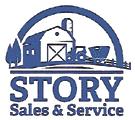 November has arrived, and winter has moved in with us Northlanders like a loutish brother-in-law who came for a weekend and stayed for six months. We suddenly nd ourselves dealing with matters concerning antifreeze, blended fuel and tire chains. We are again posing such weighty questions as, “Is it positive to positive and negative to negative or the other way around?”
November has arrived, and winter has moved in with us Northlanders like a loutish brother-in-law who came for a weekend and stayed for six months. We suddenly nd ourselves dealing with matters concerning antifreeze, blended fuel and tire chains. We are again posing such weighty questions as, “Is it positive to positive and negative to negative or the other way around?”
the growing snowdrifts that grabbed at the wheels of my Impala like giant, gooey marshmallows.



 Dear County Agent Guy MANY NEW & USED MIXERS AVAILABLE
Dear County Agent Guy MANY NEW & USED MIXERS AVAILABLE

I coasted to a stop and weighed my options. Pressing on meant possibly getting home or, more likely it seemed, getting stuck in a snowdrift.
Our light and airy warm-weather footwear has been stowed in the hall closet. We are now lumbering around in cumbersome winter boots that are so large their footprints appear to have been made by a sasquatch. The boots are so heavy that they cause our legs to become musclebound and give us Northerners that characteristic thicklegged look so many of us nd so attractive, which may explain the bump in the number of babies that arrive about nine months after the rst blast of winter.November has a way of injecting reality into our lives. It reminds us that winter is a brutal season that has no qualms about thinning the herd with cold-hearted Darwinian efciency.
This reminds me of a November many years ago when winter came early and stayed late.
I was working as a hired hand on an area dairy farm. When Saturday night rolled around, I decided to use my allotted one night per fortnight off from my job to do some of what the boss referred to as tomcatting. I preferred the more urbane-sounding term, nightclubbing.
Regardless of the designation, my objective was the same, namely, to meet and perhaps dance with members of the female persuasion. I had even been practicing my John Travolta-like moves as I brought the Holsteins up to the milking parlor.
A winter storm was predicted, but in that pre-Doppler radar era, there was grea uncertainty regarding how much snow we might get or when it would arrive. Not that possessing this knowledge would have stopped me. What 18-year-old guy doesn’t think of himself as bulletproof?
I was shocked when I emerged from the steamy, man-made thunder and lightning of the disco. During the several hours that I had been shake, shake, shaking my booty, a spell had been cast upon the land, transforming it from benign autumn to swirling, snow-choked winter. I decided to get my booty home as soon as possible.
It didn’t look too bad in town. Yes, it was snowing, but I could see nearly a block. I pointed my 1968 Impala Super Sport onto the country highway that led home.
Out in the open, it was a different situation. The wind and snow cut the visibility to the point where I could barely see the end of the car’s hood, and that’s when conditions were at their best. Complicating matters were
I slowly nudged the Impala forward, searching for an approach or an intersection. Then, I saw a pair of red reectors. Reectors that belonged to a battered old Datsun pickup.
I stopped behind the Datsun, stepped out into the maelstrom, fought my way to the pickup and knocked on its window. The 30-something male driver rolled down the window and slurred, “Hey pal, thanksh for stopping. My truck’s stuck an’ now the stupid thing died.”
The guy and the woman he was with were both drunk. I told them I was headed back to town and would gladly give them a lift.

During the arduous journey into town, the guy yammered on and on about how great his pickup had been up until now, totally oblivious of the fact he had just missed out on a new career as a human ice pop. His wife sat silently between us, staring straight ahead in an alcohol-induced stupor.
I stopped at the rst motel we happened upon. We went inside, and I plunked down a couple of days’ wages for the privilege of sleeping in a warm bed until morning. As I left the lobby, the drunk guy was alternatively haggling and irting with the female night clerk. He didn’t notice when his wife stumbled outside, bent over behind my Impala and called out repeatedly for some guy named Ralph.
And I shook my head, wondering if I should have simply let winter have its way.
Jerry is a recovering dairy farmer from Volga, South Dakota. He and his wife, Julie, have two grown sons and live on the farm where Jerry’s great-grandfather homesteaded over 110 years ago. Jerry works full time for Dairy Star as a staff writer and ad salesman. Feel free to email him at jerry.n@ dairystar.com.
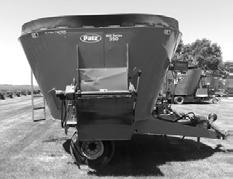 Repair vs. Replace 25060 651 Ave., Gibbon, MN Toll Free: 1-800-635-0993
www.panningbrothers.com
Used Parts • Replacement Parts FREE NATIONWIDE PARTS LOCATING We Buy Salvage Tractors
Repair vs. Replace 25060 651 Ave., Gibbon, MN Toll Free: 1-800-635-0993
www.panningbrothers.com
Used Parts • Replacement Parts FREE NATIONWIDE PARTS LOCATING We Buy Salvage Tractors



 By Steve Frericks Stearns County FSA executive director
By Steve Frericks Stearns County FSA executive director
Just like that, winter has arrived. Farm Service Agency staff are hopeful you were able to successfully nish harvest and get the equipment put away prior to this weather setting in.

The mindset of our producers shifts to plans for the upcoming growing season. Are you looking for options to start farming or a beginning farmer looking for assistance to begin a farm operation? Are you a farmer planning to retire and looking for options to transfer the farm, or an existing farmer having nancial difculties?

It can be a challenge trying to determine where to start or how to learn about options. FSA may have a loan option to assist you. An excellent place to start is the FSA Farm Loan Discovery Tool or the Farm Loan Assistance Tool. This can be found at farmers.gov. You can also contact your local FSA ofce to review the programs or discuss any questions you may have.
Agricultural producers can now change election and enroll in the Agriculture Risk Coverage and Price Loss Coverage programs for the 2023 crop year, two key safety net programs offered by the U.S. Department of Agriculture. Producers have until March 15, 2023, to enroll in these two programs. Additionally, FSA has started issuing payments totaling more than $255 million to producers with 2021 crops that have triggered payments through ARC or PLC.
Producers can elect coverage and enroll in ARC-County or PLC, which provide crop-by-crop protection, or ARC-Individual, which protects the entire farm. Although election changes for 2023 are optional, producers must enroll through a signed contract each year. Also, if a producer has a multiyear contract on the farm and makes an election change for 2023, they must sign a new contract.
If producers do not submit their election by the
deadline, their election remains the same as their 2022 election for crops on the farm. Farm owners cannot enroll in either program unless they have a share interest in the farm.
Dairy producers can now enroll for 2023 coverage through the Dairy Margin Coverage Program, an important safety net program from the USDA that helps producers manage changes in milk and feed prices. Last year, FSA took steps to improve coverage, especially for small- and mid-sized dairies, including offering a new Supplemental DMC program and updating its feed cost formula to better address retroactive, current and future feed costs. These changes continue to support producers through this year’s signup, which ends Dec. 9.
DMC is a voluntary risk management program that offers protection to dairy producers when the difference between the all-milk price and the average feed price (the margin) falls below a certain dollar amount selected by the producer.
So far in 2022, DMC payments to more than 17,000 dairy operations have triggered for August for more than $47.9 million. According to DMC margin projections, an indemnity payment is projected for September as well. At $0.15 per hundredweight for $9.50 coverage, risk coverage through DMC is a relatively inexpensive investment.
DMC offers levels of coverage, even an option that is free to producers, aside from a $100 administrative fee. Limited resource, beginning, socially disadvantaged or veteran farmers or ranchers are exempt from paying the administrative fee, if requested. To determine the appropriate level of DMC coverage for a specic dairy operation, producers can use the online dairy decision tool.










The 2018 farm bill extends loan authority through 2023 for Marketing Assistance Loans and Loan Deciency Payments.




MALs and LDPs provide nancing and marketing assistance for wheat, feed grains, soybeans, other oilseeds, pulse crops, rice, peanuts, cotton,

wool and honey. MALs provide interim nancing after harvest to help meet cash ow needs without having to sell commodities when market prices are typically at harvest-time lows. A producer who is eligible to obtain a loan but agrees to forgo the loan may obtain an LDP if such a payment is available.
Contact your local ofce for rates, terms and applications. FSA is now accepting requests for 2022 MALs and LDPs for all eligible commodities after harvest. Requests for loans and LDPs shall be made on or before the nal availability date for the respective commodities.
If loan grain has been disposed of through feeding, selling or any other form of disposal without prior written authorization from the county ofce staff, it is considered unauthorized disposition. The nancial penalties for unauthorized dispositions are severe, and the producer’s name will be placed on a loan violation list for a two-year period.
Farm Service Agency is an Equal Opportunity Lender. Complaints about discrimination should be sent to: Secretary of Agriculture, Washington, D.C., 20250. Visit www.fsa.usda.gov for necessary application forms and updates on USDA programs.
Doors are opened wide as we welcome home family and friends this holiday season. It could be called an open door policy where all are welcome. That has certainly been the case around our farm these past few weeks as we welcome home family members and new friends.
It all started with an audit. Not a visit from the IRS but a third-party audit for the Farmers Assuring Responsible Management program. We were one of 11 patrons who were randomly selected to be audited. Our eld representative Nicole assured us it would be very easy. We were already used to welcoming visitors to our farm, and our FARM binder was all in order. It was just going to be a matter of checking all the boxes.
When Nicole and Colton, the auditor from Pennsylvania, arrived on Wednesday morning, it was already one of those days. The barn cleaner broke,

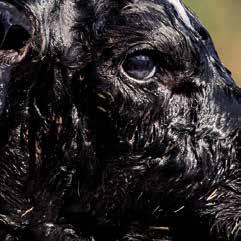





again. The cattle weren’t bedded or brushed off when they pulled in the yard. Nicole assured me he wouldn’t hold that against us, but he did note it on his report. Did I mention it had also rained for the past couple of days, so everything was pretty muddy? He noted that in his report too. I gured we would start the audit reviewing the youngstock, hoping to give the guys some extra time to get things done in the barn.
The audit wasn’t about numbers and nances. It was an independent audit of the protocols and practices we use on our farm to take care of our animals. The consumer is demanding assurances of good animal care in the production of their food. The FARM program was developed to meet those needs and allow us to use the best practices on our farms. I have to snicker. If we weren’t taking good care of our cattle, we would not be in business for very long. It is in everyone’s best interest to treat our cattle well.
Colton started with the calves in the domes. He popped his head in every dome to inspect each calf. He noted how well they were bedded and if they had fresh water and feed available. Good thing he came before the temperatures dropped and the water pails tend to freeze between feedings. He walked through the heifer lot looking for mobility issues and body conditions of each animal. So far so good.
By Natalie Schmitt Columnist




By this time, the guys were just about done cleaning and bedding the milking barn. Colton wandered up and down the main aisle and feed alleys inspecting each animal for cleanliness, body condition, broken or docked tails, bruised knees or swollen hocks. He was looking at many of the same things as a classier would but in a completely different way. It was hard to read him. I pretty much know how a classier is going to score our cows, but I had no clue how we were doing with the audit. Our animals passed with ying colors. Then, it was time for the interview.
Gathered around the kitchen island, with plates of pumpkin crunch cake and glasses of milk, we started talking. It was a very comfortable conversation and Colton seemed to relax. He was feeling right at home. After all the boxes were checked, we passed. The consumer can take comfort in knowing we are treating our animals well.
To me, it seems strange that we have to prove what we are doing. It is just common sense. We have nothing to hide. That is why we have an open door policy. All are welcome on our farm and in our home.
Our door is always open. Young friends on a long trip will make a pit-stop at our place. They know there is always a bed waiting for them. Sometimes, it is quite a surprise to discover an extra person in the house the next morning, but I’m glad they feel right at home.
Michael came home with a couple of co-workers for the last weekend of deer hunting. Guiddo is from Holland, and Mary is from Ireland. They had never hunted white tail deer and were up for a new and cold adventure. They got to the house long after we were in bed asleep and slipped out in the morning before I was up.
Once I was done with my morning chores, I headed back to the house to start making breakfast for us and our guests. Jonathon sent me a text asking if the kids could play at the farm while he and Libby went on a Christmas run. Of course. A Saturday at the farm playing with the grandchildren is a perfect day.
The hunters and the little ones all arrived at the house at the same time. It was total family chaos. Mary and Guiddo fell right into the rhythm of our crew as they became the newest members of our family. That night, we sat around the dining room table eating pizza and learning about their jobs as a reproductive physiologist and technology acquisitionist. By the end of their visit, they were homesick for their families but so glad to have a new place to call home.
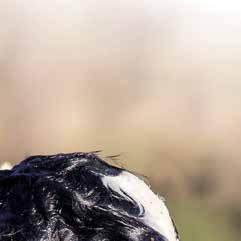
As we said goodbye to all our company and family members, we reminded them of our open door policy. Just like the end of “The Beverly Hillbillies,” “Come on back now, ya’ hear.”
The door is always open.
As their four children pursue dairy careers off the family farm, Natalie and Mark are starting a new adventure of milking registered Holsteins just because they like good cows on their farm north of Rice, Minnesota.
Ten years ago, a new chapter in our dairy farming story began: switching cows through the winter. Prior to that, we had often milked more cows than the barn could hold during the summer while the herd is on pasture, but we al-
barn, I didn’t immediately understand his vision. I couldn’t see how we’d t the barn in the space he had identied, which was a small open area between our dry cow/hay shed and our manure lagoon. But I trusted that his idea would work and, boy, did it ever. We both wish we would have switched to sand ten years earlier.
Now that we’ve got a full year of sand barn use behind us, we’ve already added another row of stalls. We’re also experimenting with outside sand stalls in the courtyard between the sand barn and tiestall barn. So far, the cows seem to really like the outside stalls – at least during the day when they can bask in the sun.
By Sadie Frericks Columnist

ways downsized to t in the barn for the winter.
For many dairy farmers who milk in tiestall barns, switching cows year round is a necessary evil. The extra milk in the tank is necessary, but the extra work can be evil. Over the past decade, we’ve found ways to make it less evil.




1. Gates, gates, and more gates. Gates are one of the most important components of a successful switching system. We have two sets of gates inside the barn. We use them like locks and dams to help usher cows into stalls. We also use portable corral gates to divide our cow yard into two sections. The inside cows go in one section while the outside cows come in for milking. (We use these sections for dividing the herd into milking groups during the summer, too.)
We only have one hard and fast rule for switching cows: Don’t mix the groups! Gates make following that rule a whole lot easier.
2. Switch cows around. For the most part, during the winter our inside cows are rst lactation Holsteins and Jerseys; our outside cows are older, larger Holsteins. But if a particular cow doesn’t do well in the inside group, we move her to the outside group. Conversely, we had one outside cow last winter who decided that laying half in and half out of a sand stall was more comfortable than laying properly in the stall; she quickly became an inside cow.







3. Housing makes a huge difference. For nine winters, our outside cows rested on an outdoor bedded pack. Last winter we moved them into sand-bedded freestalls. The difference between a bedded pack and sand stalls is night and day. Our cows are now cleaner, they milk more, and prep time during milking is a fraction of what it used to be.




To be honest, when Glen rst suggested building a sand-bedded freestall





4. Milking order matters. For the past ten winters, we milked the inside cows rst, switched the groups, milked the outside cows, and then brought the inside cows back in. Two weeks ago, after morning milking, when the cows decided the weather was too nasty to go out to pasture, we let the rst group into the sand barn and kept the second group in the barn for the day. When evening milking came around, it didn’t make sense to milk the second group rst, so we let them out and brought the rst group in. And, then, we just kept that milking order: let the inside cows out, milk the outside cows rst, switch the groups, and milk the inside cows last.
What we discovered after a couple days is that this milking order is way better than the order we used to follow. The time required for milking and switching is about the same, but the psychology is a lot better with the new way. In the past, we’d get done milking and then still have to let the outside cows out, clean stalls, re-bed, and bring the inside cows back in. Now, since all of that is done before and during milking, when we get done milking, we can shut the lights off and go to the house.
If there’s one lesson we’ve learned well in our years of dairy farming, it’s to always be open to change. Don’t keep doing things one way because that’s the way you’ve always done it. Even when you think something is going well, there’s almost always a way to do it better.
Switching from the pack to sand stalls was a big decision with a huge impact. Switching our milking order was a small change – that was hardly a conscious decision at all – with an outsized impact. Both changes denitely made switching cows better. We could have easily missed these opportunities for improvement if we hadn’t been open to switching things up.
Sadie and her husband, Glen, milk 100 cows near Melrose, Minnesota. They have three children – Dan, Monika, and Daphne. Sadie also writes a blog at www. dairygoodlife.com. She can be reached at sadiefrericks@gmail.com









